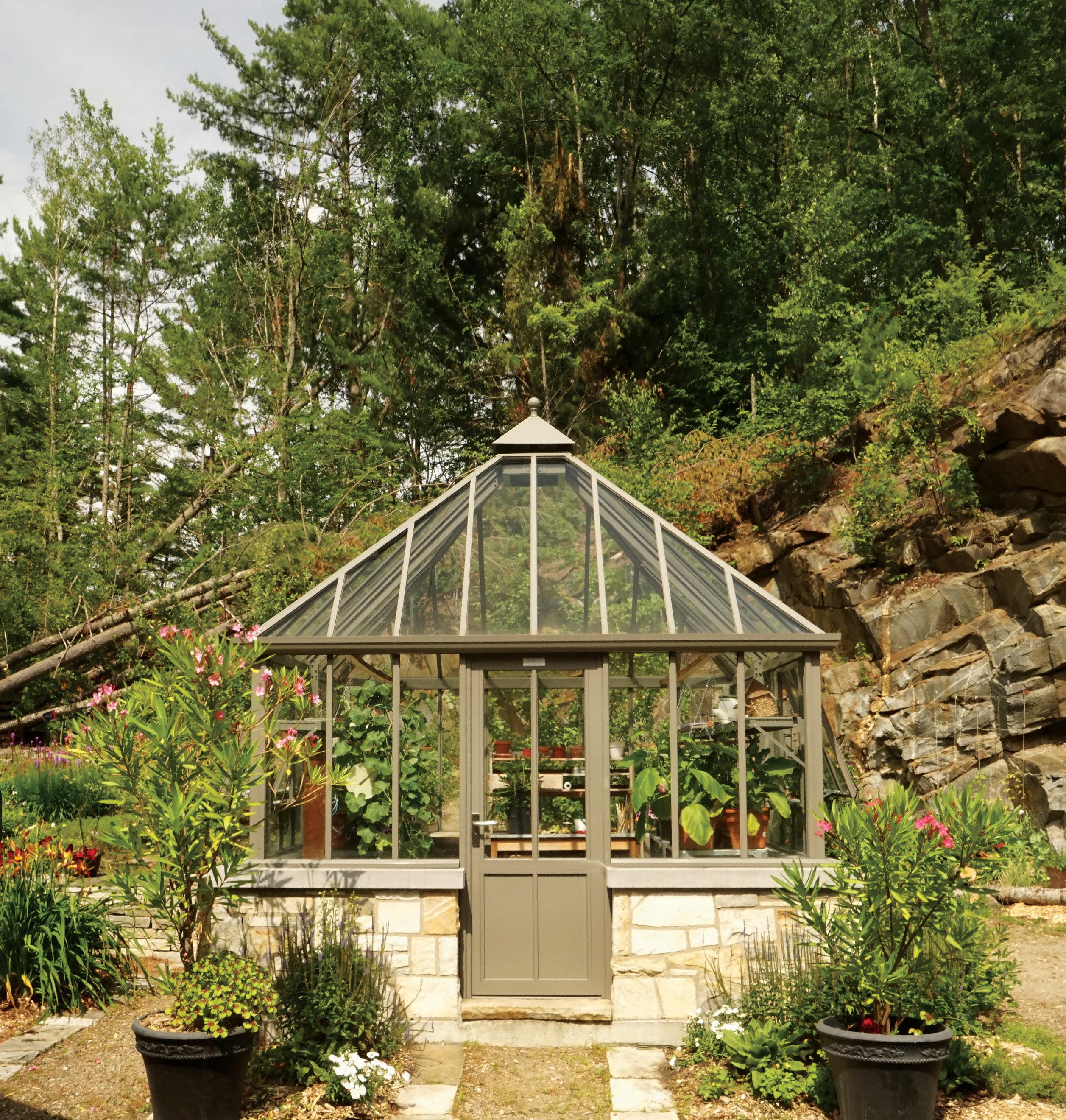


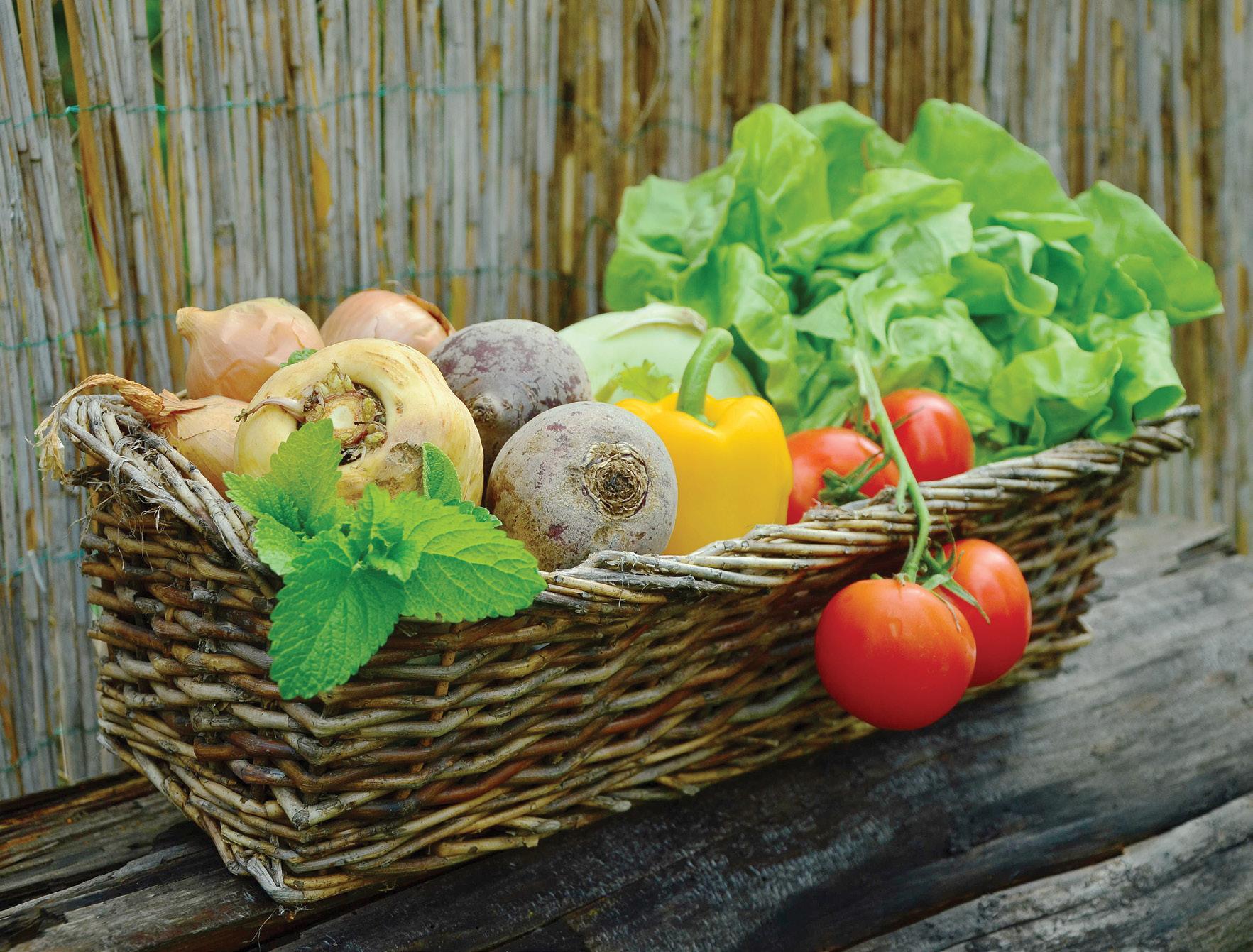











vOLuME 4 Canada’s LOC aL GardEnEr IssuE 1, 2022
On

Contributing to this issue ......................................... 4
Coming up in the Flora and Fauna podcasts ........ 5
For the love of tulips 6
Garlic: Buy once, harvest for life 12
World Gardening: Chinampas 14
Wildflowers and Weeds: Foxtail barley ................ 17
Garden guru questionnaire: Larry Hodgson ....... 18 Houseplants: Ficus ................................................ 20

Watering your plants (including trees!) .............. 23 Butchart Gardens as the 12th most Instagrammed gardens 27
Ye Two Olde dawgs: What about that new shed? .. 28 Maggie’s Musings: using the produce you’ve grown 30
Things to consider when choosing a greenhouse 34 amazing ants 36
Plant science: nematodes .....................................38 shauna’s garden Fall 2022 .................................. 40


Beautiful Gardens: Ken Popove, Chilliwack, BC ................................ 44 arlene dahl and robert Wrigley, Winnipeg 50 Kenneth Macdonald, Charlottetown 57
localgardener.net

Find additional content online with your smartphone or tablet whenever you spot a QR code accompanying an article.
Download a QR reader where you purchase apps if your phone doesn’t have one already. There are many free ones.

Scan the QR code where you see it throughout the magazine.
Enjoy the video, picture or article! Alternatively, you can type in the url beneath the QR code.
Writer Greg Auton’s work has appeared in Canada’s Local Gardener several times before. He is the force behind Maritime Gardening, a podcast and YouTube channel, where he shares his experiences growing food in his 2500-squarefoot vegetable garden south of Halifax.
In this issue he writes about grow ing garlic. He also appears in the Flora and Fauna Podcast from Canada’s Local Gardener, where Shauna talks to him about growing garlic.

Greg writes:
There is something about the whole experi ence of gardening that really appeals to me: I’m outside, in the fresh air, getting some exercise and a little sun; it’s quiet and peace ful, I am completely focused on what I am doing, like a meditation; I slow down, watch, and listen – and when this happens I always learn new things; and of course, I am grow ing my own food, and it tastes better than anything I’ve ever bought!
I grew up like many kids in the 1970s, with a modest backyard vegetable garden that my parents maintained, and when I bought my first house, I put in a garden that very year and my garden has gotten bigger each year ever since. A number of years ago I discovered an approach to gardening called permaculture, which briefly defined, involves copying the systems that work in nature, and incorporating them into to your garden design. This means moving away from rototillers, perpetual watering, perpetual weeding, pathological fertilization, and constant poisoning of pests. It’s about moving toward a far easier, less costly and more productive approach to gardening, by creat ing a garden that is designed to take care of itself.
I currently maintain a garden that is approximately 2500 square feet. It runs on manure, yard waste and seaweed, and I use heavy mulches to cut back on the need for watering and weeding. I do this all by myself. It takes very little of my time, and it is perfect for my otherwise busy profes sional life; I teach sociology at a local university and also do some consult ing.
I was tired of all the local gardening shows about flowers and ornamen tals, I’m more about the food – so I started my own YouTube channel and free audio podcast. The purpose of this podcast is threefold:
1. I’ve noticed that the practice of keeping a backyard vegetable garden, which was very common when I was a child, has really been lost on my generation and subsequent generations. Something has happened in our collective minds, such that we’ve become convinced that we do not have the time, it’s too hard, or it’s just not worth it. I want to change that and bring people back to gardening.
2. I want to introduce people to permaculture gardening. Adopting a permaculture design in your garden is really quite simple in its essence and is ideal for anyone who values a low maintenance, high output garden.
3. The prospect of getting started might be overwhelming for some. There are many costs that we associate with setting up a garden, and it hardly seems worth the money or the time. In my experience, this has never been the case. My third and final goal for this show is to show people that when they are properly designed, gardens always give, they never take.
I’m not an expert, and in fact I think no gardener can truly be called an expert, because gardening is a process of perpetual learning and devel opment. I’ll share my experiences and what wisdom I’ve gained over the years and will look forward to your feedback. Hopefully we will grow together this season and keep learning.
Follow us online https://www.localgardener.net Facebook: @CanadasLocalGardener Twitter: @CanadaGardener Instagram: @local_gardener
Published by Pegasus Publications Inc.
President/Publisher
dorothy dobbie dorothy@pegasuspublications.net
Design Cottonwood Publishing services
Editor shauna dobbie shauna@pegasuspublications.net
Art Direction & Layout
Karl Thomsen karl@pegasuspublications.net
General Manager
Ian Leatt ian.leatt@pegasuspublications.net
Contributors
Greg auton, Clive Branson, Maggie Connell, arlene dahl, d orothy d obbie, shauna d obbie, sherry Hayes, david Johnson, Ian Leatt and Michael rosen.
Greg auton, John Barrett, Todd Boland, darryl Cheng, Ben Cullen, Mario d oiron, Michel Gauthier, Larry Hodgson, Jan Pedersen, stephanie rose, Michael rosen, aldona s atterthwaite, and Trudy Watt.
Advertising Sales 1.888.680.2008
Write, email or call Canada’s Local Gardener, 138 swan Lake Bay, Winnipeg, MB r 3T 4T8 Phone (204) 940-2700 Fax (204) 940-2727 Toll Free 1 (888) 680-2008 subscribe@localgardener.net
one year (four issues): $35.85
Two years (eight issues): $71.70
Three years (twelve issues): $107.55 single copy: $10.95; Beautiful Gardens: $14.95 150 years of Gardening in Canada copy: $12.95 Plus applicable taxes.
return undeliverable Canadian addresses to: Circulation department
Pegasus Publications Inc. 138 swan Lake Bay, Winnipeg, MB r 3T 4T8
Canadian Publications mail product sales agreement #40027604
Issn 2563-6391
Canada’s LoC aL Gardener is published four times annually by Pegasus Publications Inc. It is regularly available to purchase at newsstands and retail locations throughout Canada or by subscription. Visa, MasterCard and american express accepted. Publisher buys all editorial rights and reserves the right to republish any material purchased. reproduction in whole or in part is prohibited without permission in writing from the publisher.
Copyright Pegasus Publications Inc.

Hardy apples with Bob Osborne. Bob Osborne is the owner of Corn hill Nursery in New Brunswick and has recently written the book Hardy Apples: Growing Apples in Cold Climates. He knows just about every thing there is to know about apple trees, how to plant and care for them and what kind of apples to use for what purpose.

Garlic with Greg Auton. Greg Auton, a member of the Canada’s Local Gardener editorial board, frequent contributor to the magazine and podcaster at Maritime Garden ing, brings his inimitable wit and common sense to the table to talk about how and why to plant garlic.
Indigenous gardening with Mehdi Sharifi and Dana Johnson. Mehdi Sharifi is a research scientist working for Agriculture and Agrifood Canada in Summerland, BC. He worked with research assistant Dana Johnson and others to put in the first Indigenous demonstration garden at a federal Research Station. Dana, of Gitxsan ancestry, recently graduated from University of Victoria.
Chinampas with Christopher Morehead. Christopher Morehead is a professor of Human Evolu tion and Social Change at Arizona State University. His PhD was on the archaeology of farmscapes, and he talks about chinampas, the fasci nating agricultural practice of precontact Aztecs.
• • •

Plus, soon to be interviewed for the podcast:
Sweet potatoes with Tiffany Grenkow. Tiffany Grenkow owns Winnipeg Sweet Potato, which grows and sells sweet potato slips across Canada.
Growing bamboo with Garry Hedberg. Garry Hedberg and his wife, Brenda, had a lush semi-tropical garden in Surrey, BC, featuring 9 types of bamboo.

Dealing with poison ivy with Dr Susan Pell. Susan Pell is Executive Director at the United Sates Botanic Garden. She specialized in poison ivy as a graduate student and has some interesting things to tell us about it.
Alpine gardening with Todd Boland. Todd Boland is the research horticulturalist at Memorial Univer sity of Newfoundland’s Botanical Gardens. Raised in Newfoundland, he has developed a great affinity for the flora of alpine landscapes.
Light and houseplants with Darryl Cheng. Darryl Cheng is the author of The New Plant Parent book and a popular force with his Insta gram page Houseplant Journal. An engineer, he has just released his light meter, which includes temperature and humidity measurements, to help with growing indoor plants.

There is an epidemic of love around the world – tulip festivals. They are blossoming up everywhere from the Netherlands to Turkey, from Ottawa to Japan. People just seem to love that ephemeral perennial (part of the lily family). But this isn’t anything really new. The plants have been cultivated for over 400 years, initially celebrated in Constantinople (present day Istanbul) in the days of the Ottoman Empire. However, it was the Dutch who perfected, propagated and commercialized the tulip once it had arrived from Turkey, subsequently, introducing the new discovery to the rest of the world and making a very profitable industry in doing so. The Netherlands is still regarded as the centre of tulip cultivation, growing and trading.
One of the reasons the tulips are so popular is that they can easily be transported when they are dormant, which is how tulips have found their way all over the world. Many tulip species grow in the hills and mountains of Iran, Uzbekistan, Kyrgyzstan, and Kazakhstan where the summers are long and arid. During the summer the tulip is dormant and the bulb hibernates underground. It is made from swollen leaf bases surrounding the bud that will develop into the stem, leaves and flower once the autumn rains bring the tulip back to life after the summer rest. As perennials, they don’t need a lot of attention. That occurs below the surface. Tulips produce stolons, growths that extend from the bulb to produce a new bulb a short distance from the mother plant, enabling a tulip to spread naturally without having to flower. What is even more remarkable is that tulips are ubiquitous and can grow
anywhere: in the wild, in containers, in flower beds, in the shade, in the sunshine, in rock and gravel gardens, meadows, and in woodlands. Of course it’s their brilliant diversity of hues that conjure up titles from the sublime and phantasmagorical to the obscure. Names like Madame Lefeber, Candy Prince, Christmas Dream, Flaming Puris sima, Queen of the Night, Merlot, Black Parrot, Cuban Night, and Persian Pearl, just to name a few.
Tulips have never lost their popularity over the centu ries. When Europeans were introduced to tulips, their value was similar to blue chip shares. Back in the 1660s, a single tulip bulb could fetch the equivalent of thousands of dollars. According to Richard Wilford, author of The Plant Lover’s Guide to Tulips, it wasn’t until the 1880s that breeders usurped the industry, elevating its resound ing popularity by experimenting with colour and shape formations. No other garden plant, including the rose, has aroused more passion than the tulip, yet no one seems to understand why. One theory is that the iridescent hues of tulips can be experimented with much more readily to create a plethora of complementary colour combinations each year and still look stunning. Besides the traditional clean, tidy bulb-shaped configuration, there are 3,000 registered tulip varieties within 15 to 21 distinct groups based on shape, size (height can vary depending on the amount of light available, the vigour of the bulb, and prevailing weather conditions), and blossom time (early, mid and late spring). The plant descriptions are grouped according to which colour the overall effect comes closest: red, pink, purple, white, yellow or orange.
8 of the most popular tulip festivals around the world
If you are travelling this spring, you may want to consider experiencing something truly unique, beautiful and inspir ing – a tulip festival. Below are 8 exceptional international tulip festivals worth noting. The list isn’t in any particular order, however, to be considered, the festival must have the following criteria:

• An amplitude of various tulips.
• How the tulips are arranged in creating a beautiful setting, enhancing a mood and piquing the visitors’ curi osity.

• Access to pertinent information about the tulips and the history of the facility/festival.
• Good washroom facilities, food and beverages.
• Access to accommodations.
• Areas for serious photographers. p • • •
America
Canadian Tulip Festival, Ottawa, Ontario, Canada www.tulipfestival.ca
Open from May 13 – 23
Centrally located both at Dow’s Lake at Commissioner’s Park and on Major Hill’s Park beside the Chateau Laurier. Access by bus, car, bicycle or walking.
Free of charge. Open 24/7. Welcomes more than 500,000 visitors. It dates back to 1945. It is considered the world’s largest tulip festival. Weather in May in Ottawa can be unpredictable so be prepared for intermittent rain.
Are these bulbs good? You have got to start with good bulbs! With alliums, tulips, crocuses and daffodils, it’s easy to see that bulbs are healthy. Anything mouldy or mushy is no good, neither is anything brittle. It doesn’t matter if the papery tunic on the surface of the bulb is cracked or missing, as long as the bulb inside is a solid colour and doesn’t feel soft or too light for its size.
How deep to plant them? Plant them three times as deep as the bulb is high. My question has always been, at the top or bottom of the bulb? So, for instance, if a bulb is 3 inches high, do you dig a hole 9 inches deep? Or 12 inches deep, so the top of the bulb is 9 inches deep? The answer is 9 inches deep.
Should I feed them? Your bulbs contain every thing they need for the first year of bloom. However, some people recommend adding bone meal to the planting as a deterrent to animals. If you have clay soil, it is a good idea to amend it with compost to loosen things up.
Deep pink tulips.

There are several reasons the bulbs you plant this fall may not show up next spring. It could be that they didn’t get the right amount of moisture, leaving them to either desiccate or drown and rot. They might have been on their way to rotting when you planted them. It could be that they aren’t in an area that gets enough sun, like near the wall of a house facing north.
Bulbs are ready-to-go little packets of bloom, though, and it’s unlikely that they won’t grow because of anything you did. If you planted sound bulbs in a spot that is reasonably sunny and not soggy, the most likely problem is animals.
Squirrels and chipmunks take – and deserve – a lot of the blame, but bulbs are also eaten by mice and voles. Deer and rabbits get in on the game by chomping on the plants as they emerge in the spring.
For fall damage, you can try things to discour age animals like stony mulch or predator urine. You can plant the bulbs in cages fashioned out of chick en wire, which is very effective. You could also try offering easy-to-get food as a diversion.
The critters that pilfer your bulbs are mostly not great diggers and they’re looking for an easy meal. Make sure you cover your tracks. Don’t leave freshly dug soil as a sign that there’s something to find there. Cover your new plantings with mulch and clean up any and all debris from the bulbs.
Another solution, which will help when plants are emerging in spring as well as at the fall bulb stage is to plant allium and daffodils. These are both poison ous to animals and they won’t eat them... at least, they won’t eat more than one. Some folks plant alli ums and daffodils among their tulips and crocuses to ward off hungry animals.
For eighteen days each May the city transforms into a celebration of a multi-million tulip extravaganza that decorates the city in translucent colour. Ottawa, the capital of Canada, is an attractive city with the Rideau Canal, one of the longest canals in the world. The tulip festival makes the city bloom. Each year, the people of the Netherlands present Ottawa with tulips as a symbol of gratitude and lasting friendship in appreciation of Canada’s dual role of harbouring the Dutch Royal family members and aiding with the liber ation of their homeland from the German occupation during World War II. It was whilst the Royal family’s refuge in Ottawa that Princess Juliana gave birth to Princess Margriet at the Ottawa Civic Hospital. Princess Margriet, the younger sister of the recently abdicated Queen Beatrix, is the only royal ever to be born in North America.
The Dutch monarchy fled to Canada in 1940 after the German invasion of their country. Among their problems was that the expected royal child needed to be delivered on Dutch territory to be a Dutch citizen, so Canada ceded a hospital maternity room temporarily as Dutch soil at the Ottawa Civic Hospital. There are up to 5 million tulips and 60 different varieties on display, each in pools of beds decorating Parliament Hill, Confederation Boulevard, along the Rideau Canal, pathways, parkways and en masse at the Commissioner’s Park beside Dow’s Lake. Included in the festival are outdoor concerts, international food fests, games for children, auto shows, a tea party, and a grand finale fireworks display over Dow’s Lake. It’s fun for everyone.
Tulip Time Festival, Holland, Michigan, U.S.A. www.tuliptime.com May 6 – May 14
Advisable to book your tickets and accommodations well in advance. There are three major events to discover: Windmill Island Gardens, Nelis’ Dutch Village, and Veldheer Tulip Garden.
Tulip Time Festival is the largest tulip festival in the United States. Nearly 6 million tulips are planted in city parks, at public attractions and along the streets. It has three parades during the festival: Volksparade, Kinderparade, and Muziekparade. The Festival has been going strong for 92 years with a rich Dutch history dating back to its settlement in 1847 by Dutch Calvinist separatists escaping the dire conditions in the Netherlands. In 1950 Vern Veld heer started a hobby farm with a meager 100 red tulips and 300 white tulips. Today, Veldheer plants over 4 million tulips! About 1 million visitors come to explore, gaze and be enthralled by the dazzling array of colours and activities.
The most popular endeavours are Nelis’ Dutch Village, the replica of an 1800s Dutch village and living museum with a 250-year-old working windmill that produces flour from wheat and the only operating windmill in the United States. It defines veritable cuteness as a canal circuitously meanders through the hamlet. Windmill Island Gardens features Dutch horticulture and floricul ture tulip gardens set against the backdrop of the windmill, while Veldheer Tulip Farm is a plethora of mesmerizing row upon row of blooming tulips. Purchase some handmade shoes from DeKlomp Wooden Shoe Factory or chinaware at the Delft pottery factory as a lasting and memorable souvenir.
Skagit Valley Tulip Festival, Mount Vernon, Washington, U.S.A. www.tulipfestival.org
April 1 – April 30 (depending on the weather)
Opening hours: 10 a.m. to 5 p.m.
The Skagit Valley is 60 miles north of Seattle and 70 miles south from Vancouver. You will need the festival map of the tulip fields to locate the loca tions since they don’t have fixed addresses. Due to popular demand, it is best to reserve tickets and accommodations well in advance.
Could you imagine anything more breathtaking than a tulip festival with a mountain range as a backdrop? Usually associated with winter activities, the Skagit Valley Tulip Festival in Mount Vernon, Washington has become a prime destination for the Pacific Northwest to witness millions of iridescent tulips. Debuted in 1984 by the Mount Vernon Chamber of Commerce, it broke off from the Chamber of Commerce in 1994 and became an entity of its own. Starting as a tulip festival, it has blossomed, excuse the pun, into a multifaceted month-long spectacle with an amazing assortment of activities, shows, headline concerts, exhibits and a crowd-pleasing street fair. Due to crop rotation, the fields associated with the tulip festival are in different loca tions each year. Three distinct tulip gardens are RoozenGaarde, Tulip Town, and Garden Rosalyn. It is a marvel to see ribbons of multi-coloured tulips
stretching as far as the eye can see.
The history of the festival dates back to 1883 when English immigrant, George Gibbs moved to Orcas Island to grow apples and hazelnuts. Though he only had five dollars worth of flower bulbs to plant, he witnessed how the bulbs had multiplied and, with the assistance from Dutch flower farm ers, learnt about the business of cultivating tulips, gradually making it into a successful enterprise. And thankfully we have benefitted for it has become the leading tulip production area in the Northwest region of the United States.
Keufenhof, Lisse, Netherlands keukenfhof.nl/en/
Open from March 23 – May 14 (tickets available from October onwards)
Access by bus from Amsterdam or by car. Lisse is a half-hour drive south west of Amsterdam in the heart of one of the country’s major flower-growing regions. Recommend booking several months ahead through their website.
There are 1 million visitors so expect long line-ups to the washrooms. It closes every day at 8 p.m.
It dates back to 1950 and is classified as the most beautiful spring garden in the world. If possible, avoid taking the bus. It is a long, tiring ride. Keufenhof is like a deep-hued floral tent under a foliage canopy of regimented trees. It is the Netherlands’ most popular tourist attraction during the spring. The undulat ing paths of the park epitomize a sense of tranquility amongst a kaleidoscope of breathtaking colour. Keufenhof is like entering a secret garden. Perfectly manicured beds of bloomed tulips, of every assortment, artistically arranged in a perfect sense of complementary colour pallets, punctuated with ‘special ist exhibitions’ and even a boat ride that winds through the park’s canals at a gentle pace. If you love flowers, particularly tulips, Keufenhof should be on your bucket list. There are various ways to experience Keufenhof:
• Day trip to Tulip Gardens of Keukenhof from Amsterdam (private and personal)
• Drive it Yourself electric tulip and flower fields GPS audio tour.
• Keukenhof and Zaanse Schans Guided Tours with Amsterdam Canal Cruise.
• Private Keukenhof Tulip Fields and Millions of Flower Sightseeing Tours.
• Holland Spectacle (Keukenhof Tulips Garden & Giethoorn).
International Istanbul Tulip Festival, Istanbul, Turkey www.istanbul-tourist-information.com
Open from April 1 – 30. Depending on the weather, it might extend into May. There can still be snow on the ground in March, so investigate the best weeks to come in the latter weeks of April. Try to get your tickets in advance. Free of charge. Open 24/7.
Visit the parks during the weekdays to avoid the crowds. On weekends there are often traffic jams around some parks. It dates back to 1945.
Try to plan a visit of three to four days if possible. This allows you enough time to visit a number of different locations (and to see other attractions in Istanbul). Traffic can be heavy, so it is recommended to use public transport. A metro card can be purchased at metros, tram and ferry stations and kiosks around the city.
The Istanbul Tulip Festival opens in spring to rapturous local fanfare. This is hardly surprising since tulips originated, more or less, in Turkey during the Ottoman Empire dating back to the 12th century (tulips originally grew wild in the Asian steppes). It is the national flower of Turkey. The whole city becomes a botanical garden of millions of tulips wherever this is open space. But for a real tulip treat, it is imperative to head to Emirgan Park. It is one of the largest public parks in Istanbul and has several tulip gardens. The park is open daily from 07:00 until 22:30 and can be accessed by bus or ferry. Below is a high light of each key tulip location.
Emirgan Park. This large park is the main hub of the Istanbul Tulip Festival and overlooks the Bosphorus Strait, so has stunning views. There is a promise of pleasure. The köşk mansions within the park host traditional craft demon strations such as paper marbling, calligraphy, glass blowing and painting. Musical performances are dotted around outside on pop-up stages. The park is manicured and a patchwork of over 120 different varieties of tulips with radiant colours and explosive sharpness. One display is shaped as the Turkish flag.
Do you love tulips but hate the semi-bare space of withering leaves they leave behind when they’re done blooming? Then you need to know about succession planting.

You can plant a variety of bulbs in one place and, if you time it carefully, they’ll bloom one after the other.
For example, you could plant crocuses, tulips and allium in one big hole. You would plant the allium at the bottom, the tulips in the middle and the crocuses at the top because of their size. After the crocuses have bloomed, the tulips will come forth with their glory.
As the tulips start to fade, here comes the allium to take their place. The alliums will take you right into summer and even beyond, if you leave the spent blooms in place.
You can succession plant perennials as well. Hostas are great for this because they emerge a little later in the season. The big leaves of hostas also do a good job of camouflaging the dying leaves of bulb plants.
What if you make a mistake? Don’t worry about it. Hostas following tulips are beautiful, but so are tulips among the hostas, as I saw during one extra-long spring in my mother’s garden; her white and stately tulips lasted so long with the cool weather that they looked like they were growing out of her hostas. A beautiful sight.
Sigh. Some fuss-budget gardener with too much time on his or her hands came up with this solution for leaving fading bulb foliage in the ground until it is well and truly dead.
You can’t cut back bulb foliage until it is good and yellow or even brown because the bulbs are still collecting nutrients for the next year’s blooms. The idea is you spend precious time that you will never get back braiding the foliage so that... what? It looks like something has been done to it? It looks like the gardener knows about it?
Sentiments are changing now as gardeners let dead plants of all sorts stand through winter and into spring, but if you prefer not to have dying bulb foliage spoil you otherwise green spring garden, just plant something in front of it. If that is not a solution, plant new bulbs the following fall.

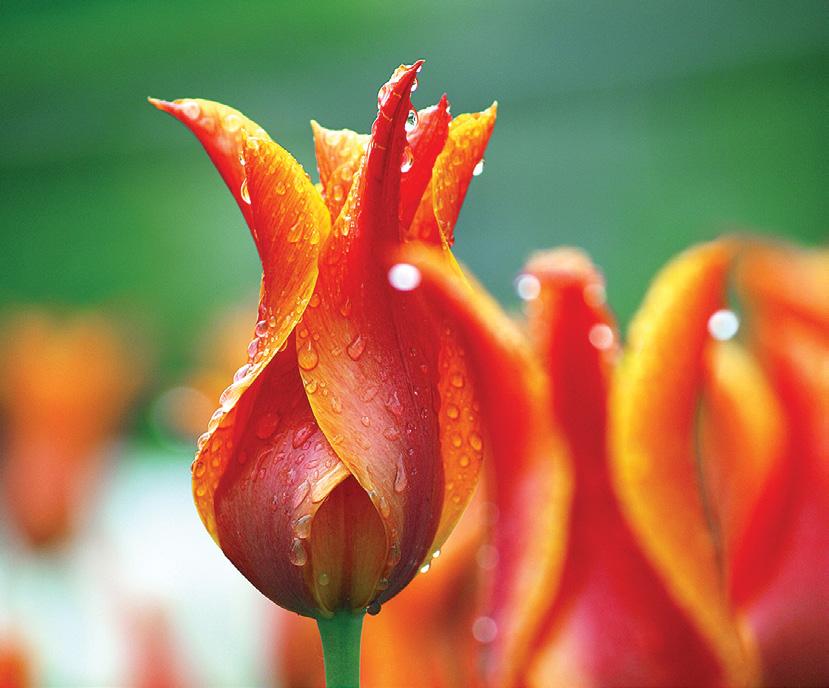
Gulhane Park. This is the most relaxing park on the historical peninsula. It runs around the lower old walls of Topkapi Palace in Sultanahmet. The park is a picturesque portfolio to wander in with gorgeous gardens, serene prom enades, outdoor cafes and incredible views of the Bosphorus Strait. This park alone features 2.5 million tulips. When you visit Gulhane Park, make sure you take in the Topkapi Palace and the Blue Mosque.
Sultanahmet Square. This is the square alongside the impressive Blue Mosque. In previous years nearly 700,000 tulips have been planted in a worldrecord-breaking ‘tulip carpet,’ measuring 1,400 square meters (1,674 yards), resembling a traditional Turkish rug.
Camlica Hill. Camlica Grove is a climb on the Asian side across to the Old City. It’s about a 20-minute casual walk uphill, but don’t let that discourage you. Thousands of tulips line the path, but it’s worth the hike as you will be rewarded by the charming journey up the hill to be greeted by a jaw-dropping scene – the best and highest view of Istanbul. Take advantage and combine your trip to the tulip garden with an excursion to Turkey’s largest mosque, Camlica Mosque.
Yildiz Park. As picturesque as a railway tabletop layout, Yildiz Park is perfect for nature lovers and families to enjoy its enchanting realm. It is dotted with old pavilions, gardens, cafes, two artificial ponds, waterfalls, streams, picnic and playgrounds in this spacious natural environment, formerly the imperial garden of Yildiz Palace. And of course, it is complemented by thousands of tulips clothing the perimeters of the paths and ponds.
Pashley Manor Gardens Tulip Festival, Ticehurst, Wadhurst, East Sussex, England
www.pashleymanorgardens.com
April 22 – May 7 (check website to confirm dates)
Opening hours: 10 a.m. to 5 p.m.
There is an entrance fee and no group concession price during the festival. No pre-booking. Free parking. On-site cafe/restaurant, picnic site. Less crowded during a weekday.
Unlike some of the mentioned tulip festivals adorned with millions of tulips, what British gardens lack in numbers, they make up for in quintessen tial English presentation, usually in the confines of medieval castles, extraor dinary manor homes or opulent gardens. Such is the case with family-owned Pashley Manor Gardens in East Sussex. It is a Tudor manor home (1550) but extended during Queen Anne’s reign (1720) and decorated by 11 acres of award-winning gardens dating back to the 16th century. It has been claimed as ‘one of the finest gardens in England,’ and a former winner of the Chris ties Garden of the Year Award. What you eat in the cafe is freshly produced from one of the gardens. If you like strolling through romantic landscapes with vine covered arches and innovative planting schemes, including an infu sion of 500 old trees, trickling springs, fountains, decorative pool, and other water features, then Pashley will be a delight. The Pashley Manor Gardens Tulip Festival is a perennial favourite as visitors come from all over the country to see more than 48,000 tulips of 105 varieties (all clearly labeled) planted in colour themed garden ‘rooms’ throughout the grounds. Each year, the Festival introduces ‘special tulips’.
Tonami Tulip Fair, Tonami Tulip Park, Tonami, Japan fair.tulipfair.or.jp
April 22 to May 5
Opening hours: 8:30 a.m. – 5:30 p.m.
The Tulip Festival’s duration is limited, but the Tonami Fair is open all year round to enjoy the other assortment of flowers, including cherry blossoms.
You can purchase tickets online (though this is not essential) or on-site. Access by car, taxi or train. Tonami is directly west of Tokyo close to the west coast.
A magnificent festival of tulips seems so appropriate in the land of the rising sun. Delicacy, grace and discipline are Japanese virtues. It is an ideal family retreat featuring a combination of 2.5 million tulips in 600 varieties in this floral epicentre, kid’s fairground, and adult leisure wonderland. Today, Tonami City, directly south of Takaoka, is the leading producer of tulip bulbs in Japan since 1918, growing over 250 varieties of the flower. The park has an assortment of towers, walking paths, fountains, ponds, observation decks,
Fresh pink tulip at the 2019 Tulip Festival in Ottawa. garden bridges, exhibitions, amusement rides, cafes, live stage performanc es, a mini bullet train ride, a tulip museum, and a gallery/workshop offer ing a cornucopia of information about tulip cultivation. The layout is aptly designed for flower photographers.


Srinagar Tulip Festival, Kashmir, India www.indianholiday.com
April 3 – April 30 Opens at 8 a.m. and closes at 7 p.m.
Very reasonable entry fee. Srinagar is accessible by train, plane, bus, car or taxi. Srinagar tulip garden is located 8 km (5 miles) from Lal Chowk (the main city centre).
In 2007 an attempt was made to bolster revenue in Srinagar, a small town near Kashmir, India. The Chief Minister of the Jammu and Kashmir state decid ed to try something unconventional, a tulip festival. It has since become one of South Asia’s most popular and cherished events. Spread across 30 hectares, 12 million tulips of 62 varieties decorate the gardens of the Botanical Garden, Chashme Shahi, Nishat Bagh, Mughal Bagh, Shalimar Bagh, Pari Mahal and the Zabarwan Park. Visitors have said the streets and fields in and around
Srinagar are blanketed like floral carpets. In fact, your trip to Kashmir would not be complete without visiting Asia’s most extensive Tulip Garden. While you’re there, stop by the many folk dance performances on the street, kiosks and craft shows, and, of course, sample the local dishes that confirm why Indian food is so irresistible. Another reason why Srinagar is so memorable is because of the natural beauty that surrounds it, including the foothills of the Zabarwan mountain range reflected off Dal Lake. This famous lake is so pristine it is described as ‘paradise on earth’. Take a Shikara Ride, a traditional Gondola-type rowing boat, to truly experience such a pleasure. Overall, it’s a beautiful way to celebrate the arrival of spring. • • •
For the past 25 years, Clive has been an advertising creative director/copywriter. Since 2012, he has had three books published and is presently working on another entitled Plugged In, Tuned Out regarding his observations on contemporary life from A to Z.
Since 2003, Clive has been a freelance writer, photographer and a monthly contributor for four magazines. He lives and works in Ottawa.
Crisp white tulips at their peak.

Garlic plays an important role in my family's diet, and we proba bly eat it every day in one form or another. For that reason, I plant a lot of it in my garden and harvest about 250 heads a year. This may sound like a big project, but garlic is dead easy to grow, harvest and store. The other great thing about garlic is that some of the bulbs can be replanted each year, allowing free garlic in perpetuity.
The two main categories of garlic are “softneck” and “hardneck” garlic. Soft neck garlic tend to have many cloves, and they have soft and flexible stems. In general, they are recommended for warmer climates, though there are vari eties that are hardy to Zone 3. Hard neck garlic are well-known for hardi ness and tend to be recommended for colder climates. They have stiff upright stems (aka “hardnecks”) and they tend to produce fewer cloves, but the cloves are larger on average than those of softneck garlic. Hardneck garlic also produce a flower stalk called a “scape”, and it can be eaten if harvested at the correct stage of its development. The first seed garlic that I ever bought were hardneck garlic, and since I have been replanting those garlic ever since, that is all I have ever grown.

For the Canadian gardener, my recommendation is to plant hardneck garlic in the fall. The timing is impor tant because good root development is desired, but sprouting is not desired. Plant too early and the warm fall days will cause the cloves to waste energy sprouting. Plant too late and the roots will not develop before freeze-up, which will delay growth in the spring. Neither of these contingencies are the end of the world; the garlic will still probably grow but they will not achieve optimal size.
All this talk about optimal timing sounds complicated, but it’s really not that hard. Just watch nature. When the leaves begin to change colour, and the geese are flying overhead, and the first frost appears – that’s when it is time to plant garlic. Where I am, that is usual ly during the first 2 weeks of October, but sometimes I plant in late Septem ber too. When the leaves really start to fall it’s time to stop procrastinating
and get those garlic in the ground!
Choose a spot with good soil and lots of sun. Break the bulbs into indi vidual cloves, space them out about 6 inches apart, plant each clove about 3 inches deep, and then cover with about 4 inches of mulch (fall leaves are ideal for this – small leaves are best, but large leaves can be made small with a lawn mower). The mulch is critical because it performs a range of useful functions:
1. It keeps the soil temperature constant in the fall, so the warm days do not cause the garlic to sprout.
2. It delays the freezing of the soil, so the bulbs get an extra couple weeks of root development before the soil freezes.
3. It keeps the soil moist in the spring and summer. I never water my garlic. Ever.
4. The leaves feed soil organisms that provide nutrients for the garlic like a slow-release fertilizer.
5. The leaves smother out weeds. The garlic sprout has no problem push ing up through them, but most weeds are smothered by 3 inches of leaves.
There are two stages to the harvest ing process. The first is the harvesting of the garlic scapes. These appear in mid to late spring and they are easy
to spot. At some point, a thick stem shoots up above the foliage, does a couple 360 degree turns, then straight ens out and produces something like a flower called a bulbil. It is important to snap the scape off at its base after it has made one complete 360-degree turn. Doing this forces the plant to put all of its energy into the bulb, which means bigger garlic. Also, the scapes can be eaten. They have a mild garlic taste and can be used for any dish that calls for garlic. They can also be turned into pesto or blended into a paste and frozen for later use. Later on in the summer when four or more of the leaves have turned brown, and the plant starts to look like it is dying, the garlic can be harvested. To harvest, just pull them out of the ground and then leave them in the sun for a couple hours to dry off the dirt.
Garlic need to be cured after they have been harvested. There are a number of ways to do this, but I find the simplest is to remove the root hairs with scissors or a knife, cut the stems to about 3 inches long, and brush off any soil or other loose material with your hands. Next, space them out on cardboard on a garage or concrete basement floor under a fan (or a simi lar situation with good airflow) and
https://maritimegardening.substack.com/p/how-tomake-garlic-scape-paste-c67#details


leave them like that for about 2 weeks. To store, simply keep them somewhere that is about 10° Celsius. For longterm storage, keeping them below 5° Celsius is better. In a fridge they can sometimes keep for an entire year with only minor degradation. To reserve some for fall planting, set aside the largest bulbs with the largest cloves. Big cloves make big garlic.
White rot is caused by the fungus named Stromatina cepivorum. It is brought into a garden by planting infected garlic. There is no known chemical treatment for white rot and it can remain dormant in the soil for 40 years. The best way to avoid bringing white rot into a garden is to only plant certified seed garlic. If white rot is identified, the options are waiting 40 years to try again, or moving to a new location, or possibly a treatment called soil solarization, which means using plastic covers during summer months to heat the soil to high temperatures that kill the dormant form of the fungus (and anything else that can’t get away).

Nematodes are tiny, microscop ic worm-like organisms. Healthy soils have nematodes, and they are a perfectly normal thing, but unfortu nately, some species love allium plants and will wreck a garlic garden. The visible symptoms vary, but stunted growth is a common factor. If inspec tion of the bulbs reveals abnormalities, it is worthwhile to research the specif ic symptoms to determine whether nematodes are present. The standard treatment is to quarantine the soil area for four years, but this will only work if other host plants are not grown in the soil during that same time.
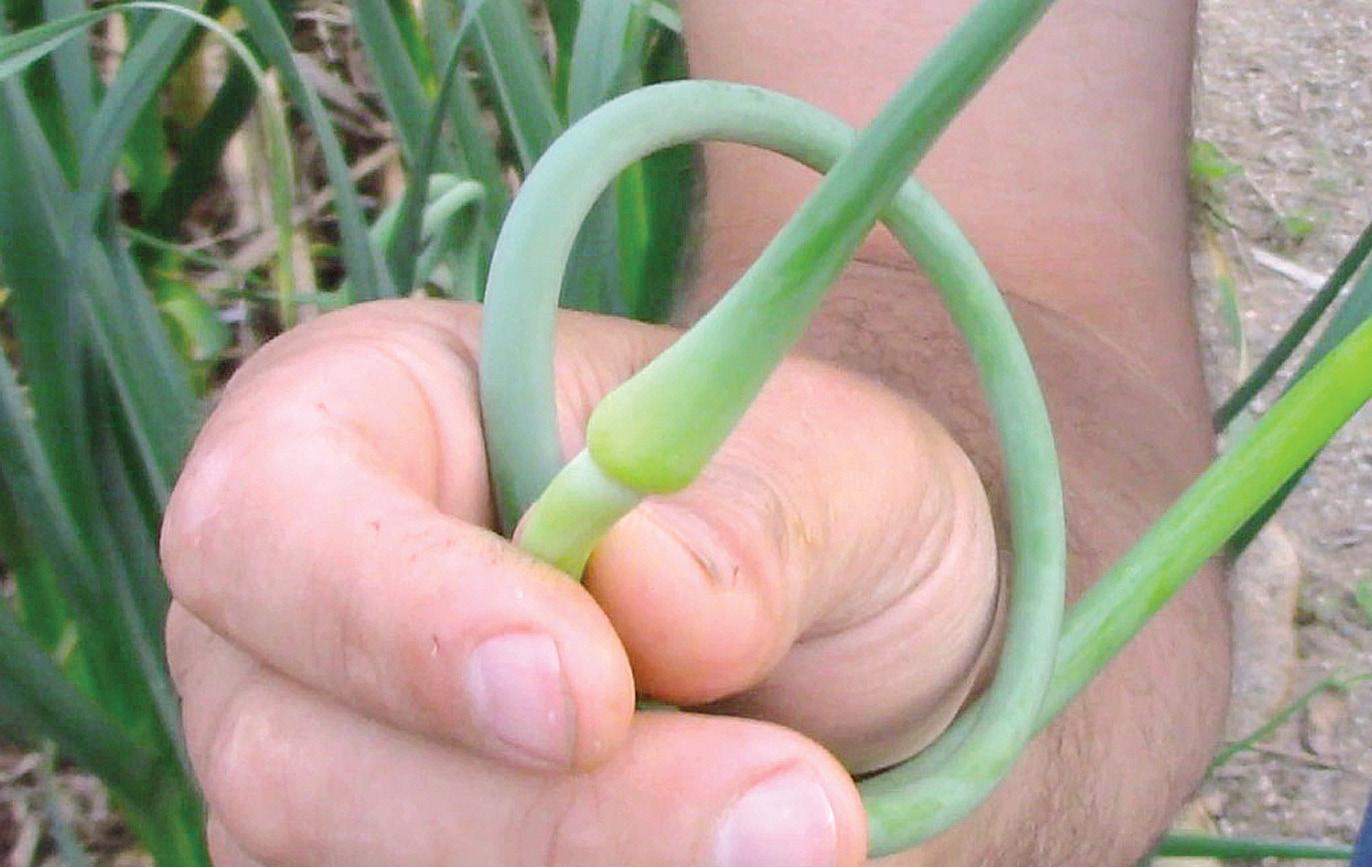

It may sound too good to be true, but garlic is the ultimate plant for the gardener who wants a low-cost, culi narily versatile, easy to grow, and easy to store vegetable. Give them a try this fall and perhaps, like me, you will have free garlic for life! p
When preparing the garlic for storage it is important to remove the
hairs and all but 2 inches of the stem so that they can properly dry and cure.
Have you heard of chinampa agriculture? It was prac ticed by Aztecs in the area of present-day Mexico City and you hear about it referred to as “float ing gardens” sometimes, though the fields don’t actually float. Chinam pas are more like artificial islands built in shallow lakes, with food and flowers grown on the islands. The base of the garden goes all the way to the lake bed.
The predecessors of chinampas may have begun as long ago as 1000 BCE, but we can say a lot more about those from the Aztec Empire, which began in 1428 CE. In fact, many exist today, and many are still farmed. You can visit them if you’re in Mexico City. Others are over grown.

A typical chinampa is around 15 feet wide and could be up to half a mile long. The islands were formed by piling muck from the bottom of the lake and compostables, and the banks of the islands were shored up with posts of willows or cypress, some of which grew into trees.
Although the presumption of many writers is that chinampas are natu rally watered from below by the lake they are in, it doesn’t seem to have
A well-farmed contemporary chinampa.
been the case. The capillary action of water has been overstated; it requires a type of soil that chinampas didn’t have, according to researchers. In fact, we know that chinampa farmers historically watered their fields from the lake surrounding them, using fabric bags on long poles.
So, what’s the advantage of having fields in lakes?

First, it’s easy to get around and
between them by boat. Second, the water is, of course, nearby, and nutri tious muck from the lakebed could be piled on top to replenish the soil. Third, the islands were a method of forming new land where there are lakes and swamps. Fourth, and most important, is that the proximity to the water mitigates rapid tempera ture changes. Just as when the Cana dian gardener waters early on a fall
BOB’S SUPERSTRONG GREENHOUSE PLASTICS. Pond liners, tarps. Resists Canadian thunderstorms, yellowing, cats, branches, punctures. Custom sizes. Samples. Box 1450-O-G, Altona, MB, R0G 0B0. Ph: 204-3275540 Fax: 204-327-5527, www.north erngreenhouse.com.
To place a classified ad in Canada’s Local Gardener, call 1-888-680-2008 or email info@localgardener.net for rates and information.
Join the conversation with Canada’s Local Gardener online! www.localgardener.net Facebook: @CanadasLocalGardener Instagram: @local_gardener Twitter: @CanadaGardener
morning to prevent the ravages of an early frost, the Aztec-era farmer benefitted from the ameliorating effects on a cold dry-season morn ing. This, combined with the very nutritious lakebed muck, gave chinampa farmers multiple harvests per year.






Chinampas have been romanti cized from the time Europeans first saw them. Early accounts, prob ably based on viewing from afar, really did believe the gardens were floating. They told stories about being able to move the garden at will, though there is no evidence to support this ever having happened. It is supposed that conquistadores saw a canoe transporting seedlings through a canal and presumed that was a chinampa.


There are a few folks with stars
in their eyes trying to make their ideals about chinampas come true, and more power to them. In truth, though, it seems that this method of gardening or farming is related to the political and social structure of where it started. It seems unlikely that success with chinampa farming will have much effect on contempo rary Canadian agricultural practice, but it never hurts to dream. p




Like a lot of children, I loved this grass when I was small. Tufts of it sprout up on the prairie, the hairs glistening like Swedish children in the sun. You gather it in the crook between your thumb and forefinger and feel the smoothness as you run your hand from the grass to the tips – but only rub it very lightly, because if you apply any pressure it will resist.
The Latin name is Hordeum juba tum and it is a native species to Canada. It has a bad reputation, though, and not without reason. The hairs of the foxtail, which are actu ally awns, have tiny barbs along them that can help the awn work its way into your dog’s ears, eyes, nose and mouth. They can do some nasty, even fatal, damage to your pet. Many wild animals and livestock can eat foxtail barley before it flowers. Once the awns mature, though, the barbs will get stuck in the animals’ throats and digestive systems. This is an overstat ed issue; any animal that is frequently felled by foxtail barley would not exist in the same area for long. Still, given how much dog owners love our pets, it’s wise to keep them away from the plant.
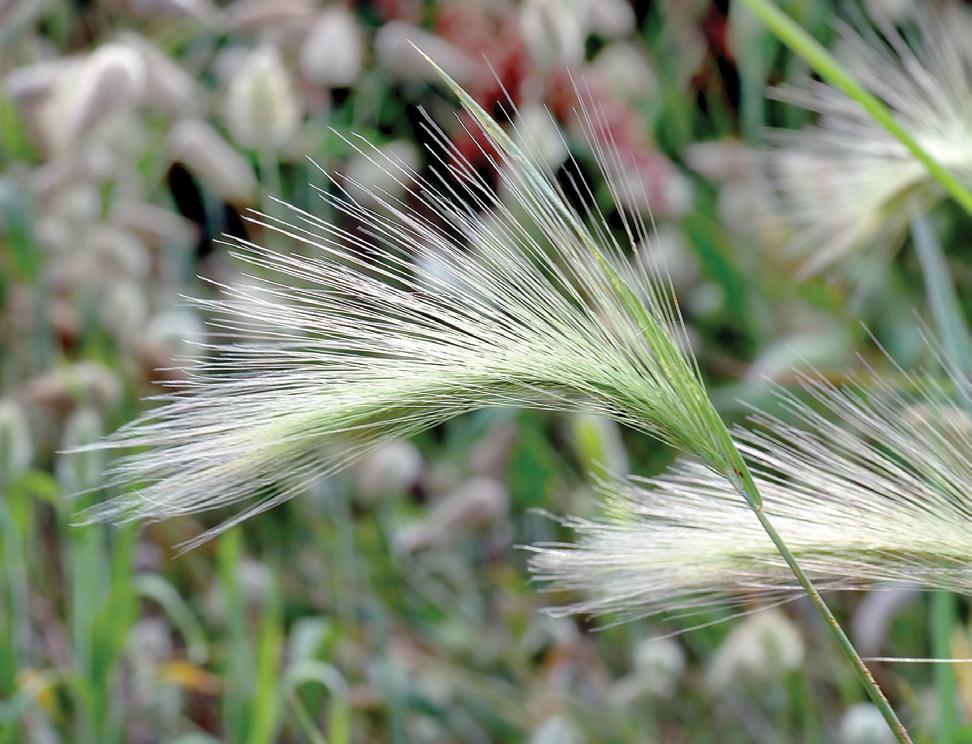
These barbed awns are part of foxtail barley’s method of reproduc tion: they stick to whatever might be passing by, hitching a ride to a new place to start proliferating. If they land in soil that is neutral to alkaline and if the area is sunny, the seeds have found a home. They don’t care if it is loamy or sandy or mostly clay.

The plant is a short-lived perennial but it sows easily. The roots don’t go very deep and it should be easy enough to pull if you find it in your lawn – which you shouldn’t, because it doesn’t care for competition from other plants. You’re more likely to find it in boulevards that haven’t been maintained or along roads. It can get a foothold next to the highway because it doesn’t mind the winter salt that kills just about everything else.
Some sources say that it is invasive in Canada. Others prefer to think of it as opportunistic, since it is native. (Can a plant that has developed over
thousands of years in a place truly invade it?) And while it only needs sunlight and just about any kind of soil, the seeds aren’t the sort that will like waiting, deep under the soil, until you happen to lift them to the sun. They tend to live for a maximum of about three years.
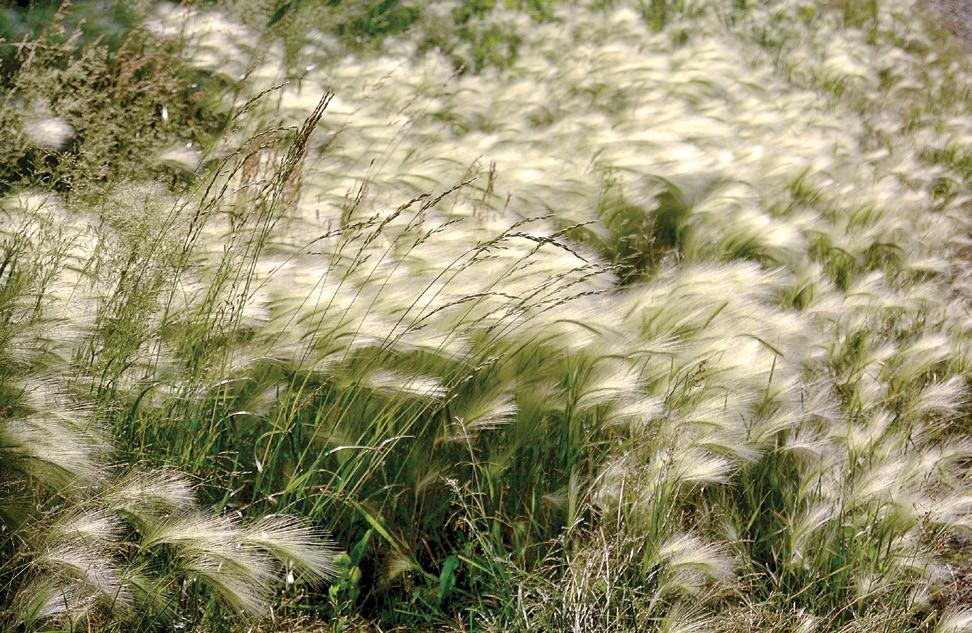
Foxtail barley is technically edible by humans. The seeds can be roast ed and ground as flower or used as
a substitute for coffee, but they are a pain to deal with and not especially toothsome. It has been said that you can make a poultice from the roots to treat sties, though it doesn’t seem to work well enough to have many people using it. The value to people lies in its good looks, and while Canadians tend to look askance at it, in Great Britain it is planted by gardeners. p


Name, position, city: Larry Hodgson, freelance garden writer and blogger, Québec City.
How and at what age did you learn to garden? My father taught me as a young child, probably start ing as a toddler.
Favourite place to relax in the summer. On my shady deck, putter ing about in my container plants.
Favourite place to relax in the winter. In my solarium, puttering about in my houseplants.
Insects. How do you feel about them? What do you do about them? I’m amazed by them. I love studying them, watching how they move and feed. Especially when they’re on other people’s plants.
I’ll often squish a pest instantly, especially one that does a lot of
damage fast, like a slug (for whom I have no sympathy). Minor ones, I quite often just ignore or simply blast with water to knock them off the
plant. Plus, Ma Nature often steps in and takes care of them. I don’t use poisons, but will treat with soaps, oils, beneficial organisms (like BT).
How about weeds? I’m not a hoer or rototiller but do pull ones that annoy me. I’m pretty easy on them. More a “pull one here and here as I stroll” person than a “get down and aggressively remove each one” type.
Something you’ve always wanted to do but have never gotten around to. Put in a rooftop garden. I have a wall garden and a fireplace garden, but nothing on the roof.
Where is the most beautiful place you’ve ever been? What made it beautiful? Tough question! I’ve trav eled so much! That would have to be East Ruston Old Vicarage Garden in Norwich, England. Stunning garden
with so much ingenuity, brilliant landscape ideas and beautifully inte grated plantings. The weed garden, where all the plants are considered weeds, was brilliant.
What plant do you love that people don’t use often enough?
There would be hundreds of those! I’ve written two 300-page books on my favorite plants (in French), just to give you an idea.
Just looking out my window to see what is blooming right now, how about tree mallow (Lavatera thuringiaca)? It’s like a giant mallow (70 inches) that flowers for three straight months. It’s always writ ten off as not being hardy, but that’s clearly a mistake. It grows wonder fully in Zones 3 and up. You should see the patch in the Van den Hende Botanical Gardens planted 60 years ago and still going strong. It has changed names, by the way. The genus Lavatera exists no more. It is now officially Malva thuringiaca. ‘First Blush’ is a nice white one.
What plant are you tired of seeing because it is overused? I don’t get excited about certain plants anymore, but if people plant them and it gives them pleasure, that’s fine with me. I’m not sure the world really needs a new orange pompom African marigold, though.
Name the person in the world you most admire and tell us why. That would be my father. He tended my fascination with gardens as if I were the garden and it bloomed inside me. It led me to an extraordi nary life I would never have other wise known.
What have you achieved that you are most proud of? I’m proud of so many things I have done. Most proud? That would be my son, Mathieu!
Tool you cannot live without. Computer.
If you were to move to a new house and start a garden, what is the first thing you would do? Start pulling out lawn and installing food and flower beds. I wouldn’t be able to stop myself.
What is the biggest mistake you’ve ever made, garden-wise? I have made so many! Theoretically, I should say buying a house in winter with close to 6 feet of snow on the ground would be the worst, as here I was, so happy to be gardening in my own space, only to discover the
back and side yards were covered in asphalt! But – and it’s a big but – I now look out over my yard filled with flowers, shrubs, trees and vege tables, inhabited by all sorts of amaz ing animals and always full of sing ing birds, and have to admit … that “mistake” turned about pretty well!
Of the mistakes still with me are plants I planted before I checked to see if they are invasive and now are serious weed problems, like Euphor bia cyparissias ‘Fens Ruby’ and Gera nium thunbergii ‘Jester’s Jacket’.
If you couldn’t be involved in the green industry, what job would you choose? Teacher … which is
what I trained to be, actually.
Tell us something about you that will surprise us. I have two webbed toes on each foot. Shocking, isn’t it!
What would you like new gardeners to know? Just how easy it can be. Plants want to grow. Give them half a chance and they will. And if you give them more than half a chance, they’ll thrive… and so will you! p
• • •
We at Canada's Local Gardener were sorry to hear of Larry's passing on October 26, 2022. He was a tenacious researcher, a prolific writer, and a truly joyful person. He will be missed.
With hearing loss, the high notes of your garden may be missing. Bird song, the sigh of the wind and the laughter when something goes particularly well. Get back to fully experiencing your garden!
Hearing loss has been associated with depression, loss of memory and thinking skills, feelings of isolation and so many more health risks that take away the joy of life.

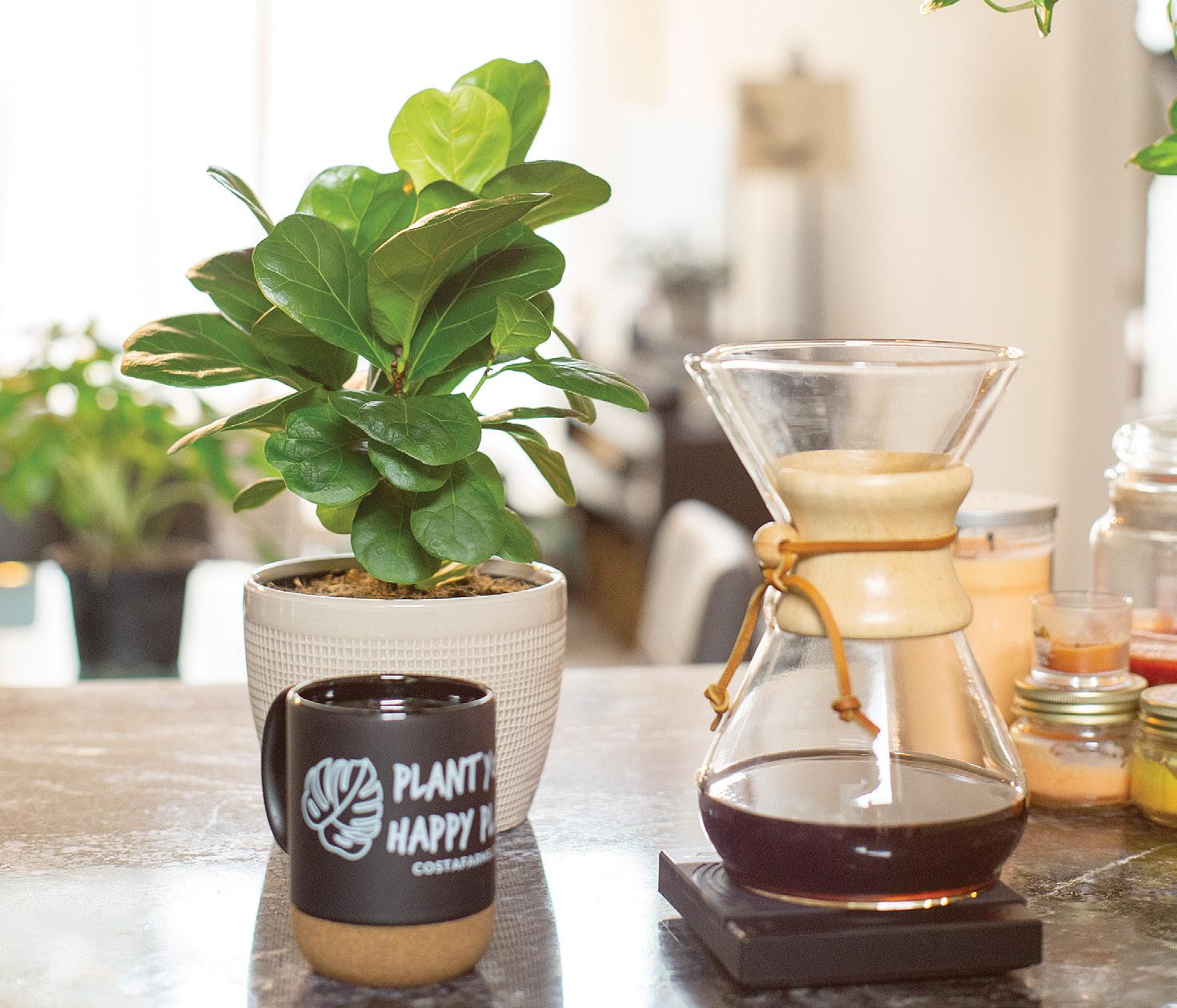
 By dorothy dobbie
By dorothy dobbie
There are 750 species of figs in the world. Some of them bear delicious fruit. All are lovely and worth growing. We shall look at just three of this legendary plant.
There was a time when you spoke of fig trees and everyone had the same vision in mind, the tree with the pleas ing shape and shiny, heart-shaped leaves, botanically known as Ficus benjamina, or weeping fig.
The weeping part did not refer to its shape as in weeping willow, it referred to its curious habit of dropping leaves when it is unhappy. And it is easily made unhappy by moving it from one place to another, by giving it too much or too little water (err on the side of too little), by giving it too much or too little light (it likes bright, indirect or filtered light)
In one case, it also proved its name in a more obvious way. We had just moved into a new office and decided to give all the plants a treat by repotting
them. They all perked up right away –all, that is, except Miss Benjamina. She dropped all her leaves and then sulked. After a while, when we were almost ready to toss her out, she began to send tears out the ends of her smallest twigs. Then, protest over, she followed this demonstration with tiny, new leaves. In a couple of weeks, she looked glorious and happier than ever.
What did we do to make this happen? Nothing, which is the best thing to do to this temperamental but lovely house plant. It does not even like to be turned toward the light. When you find its happy place, just let it be.
Ficus benjamina can grow quite large so be sure to give it a large enough container early in life as you can see how they resent being repotted. They
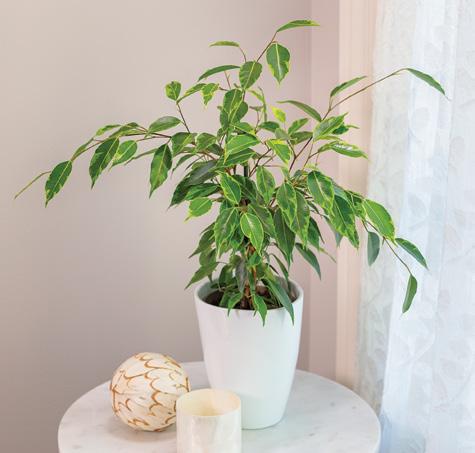
can attract mealybugs, scale, and spider mite but if well cared for in a plant disease-free home, they should be fine. Misting is always a treat – they like high humidity and the bugs do not.

Fiddle leaf fig, Ficus lyrata, is just as finicky. Its large, deeply veined, violinshaped leaves are vulnerable to our dry Canadian winter air and the plant does not appreciate sudden drafts or the gloomy light of the dark months. It needs time to adjust under even ideal conditions, but mostly, this plant needs good light. This is not a plant to set up in the basement rec room and just like F. benjmina, F. lyrata needs bright but filtered light. If morning light is what it will get, forget the filtering. Give the plant a little distance (three or four feet) from the window if it faces west.
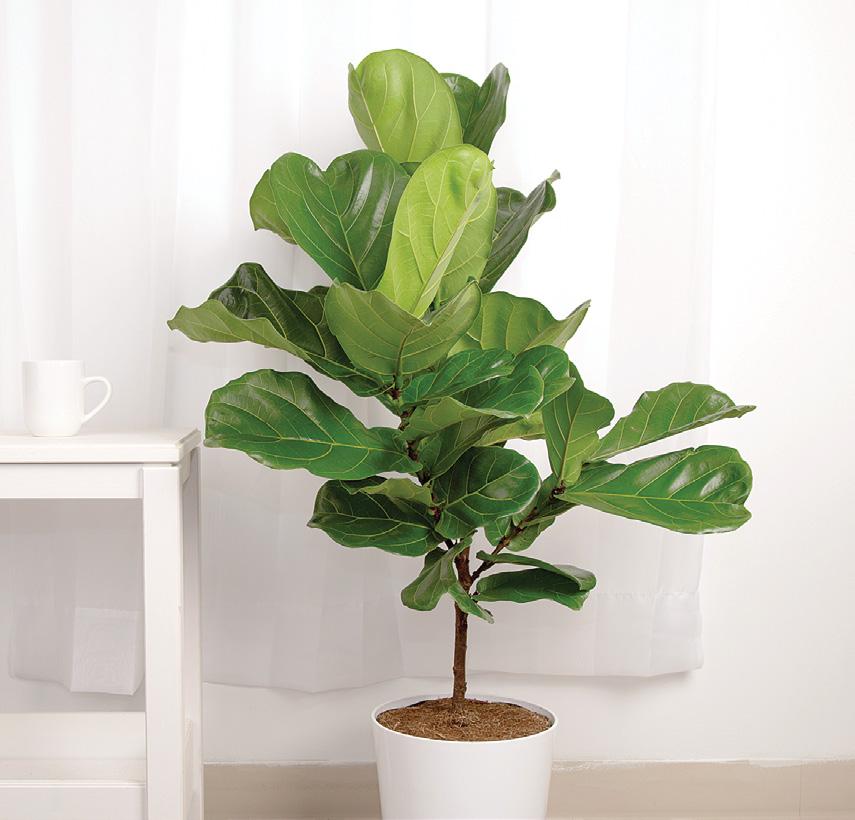
Signs of stress include browning of leaf edges and leaf drop.
Both plants like consistency. Water the same amount each time and not too often – let the soil dry out a bit, but when you do water, do so thoroughly until the water runs out the bottom of the plant. Do not leave either plant standing with wet feet.
F. lyrata benefits from repotting annually in a slightly larger container and with a bit of new soil. You can fertilize monthly through spring and summer, then stop. Let the plant rest.


It is vulnerable to spider mite so mist the plant occasionally because spider
Scan
Watch this if you’re thinking of growing fruiting fig trees in Canada.
https://www.youtube.com/watch?v=l6nzG6RicoI&t=2s
mites hate humidity. Brown spotting surrounded by yellow can indicate a fungal disease due to poor air circula tion.
The fruiting fig tree will bear its deli cious berries for your snacking pleasure when they reach about three years old.
In its natural habitat, the original of this plant has formed a unique rela tionship with wasps specific to their needs. The wasp fertilizes the “flow ers”, which grow inside the fruit, by crawling inside it and laying eggs while depositing pollen from the tree it was born in.
The variety you will grow, Ficus carica, was bred to require no pollina tion. Just as with the other ficus, it needs good light, at least for the summer, between June and September. Winter is a dormancy period. In Canada – south ern Ontario, Vancouver – it can even be overwintered outside with a little care. F. carica does lose its leaves naturally in the fall. Bring it inside after the first
light frost which will help to initiate the leaf drop and ultimate dormancy.
Like other ficus, it needs good drain age and light but nutrient rich soil. Water well during the growing period and very lightly in the fall and winter months. Keep it cool during dorman cy and low light levels are fine. A cool basement with the occasional watering is all you need. It will start to reawaken in late February when you can bring it into the light again and increase water ing and begin feeding.
Do not expect flowers to herald the appearance of fruit. As mentioned, the flowers grow inside the fruit, which will suddenly emerge from the end of twigs on the plant. Containerized, F. carica will reach 3 to 8 feet.
In general, prune figs lightly in spring or early summer wearing rubber gloves to avoid contact with their irri tating sap. To transplant, wait until early spring. Water well a couple of days before the move to a slightly larger pot adding well-draining soil.
Fruit drop can occur in a young plant or if it is not getting enough light and warmth.
Even the smallest trees can bear a good amount of fruit. Once the fig is happy, it can produce as much as 200 pounds of figs in a season!
Historians say that figs were the first domesticated plant. Many origin stories, including those in the Bible, include references to figs. p






As we prepare for another beautiful Canadian winter, much of our gardening attention will naturally be directed towards the indoors, to our indoor plants. Most indoor plants are well suited for the limited sun that our Canadian homes experience during the winter through a diversity of exposures (direct sun, partial sun etc.) and soil conditions (sandy, black earth, wood chips) to thrive in. Luckily, most plants have similar requirements for the type of water they need. “Type” of water you may ask? Isn’t all water the same – good old H2O? Well, it is a bit more complicated than that (and your plants and trees will benefit!).
Water 101
We all know of the beauty of plants, including trees, and we all want them to be healthy and to live a long life with us. All plants manu facture their own food through photosynthesis. To do this they need sunlight, soil and yes, water. All the metabolic processes and biological activities that take place inside plants are directly dependent on water. Every cell of the plant needs water for survival. With out water, plants cannot perform photosynthesis, respiration, and translocate food (photosynthate) to different parts of the plant. Water cools the plant as the plant tran spires. Also, without water in the soil, plants cannot absorb the nutri ents they need to survive (soil nutri ents dissolve in the water).
Water allows microorganisms (and in the case of trees, mycor rhizae) to live. Microorganisms allow for a better uptake of nutri ents by the plant. Mycorrhizae are a type of fungus, some of which have a symbiotic relationship with trees in the procurement of nutri ents, converting unavailable forms of nutrients into available forms to help plants and trees grow.
Water in plants gives it shape and provides mechanical support.
The best water to use is the type of water your plants are used to – rain water.
When a plant loses water, it will wilt and when a tree loses water it can wilt and break with the plant not having the mechanical support to stand straight.
To most people, water is water: H2O, de l’eau, agua, Wasser, and so forth. In other words, it’s all the same. Well, there is a huge differ ence in types of water, some which
can negatively affect your plants. Think about it; there is city water, well water, rainwater, distilled water, filtered water and more, and the differences between them can be staggering. Besides differ ences in pH (the measure of acid ity) there is also the amount and type of dissolved solids within the water. Total dissolved solids (or “TDS”) is the amount of organic

and inorganic materials, such as metals, minerals, salts, and ions, dissolved in water. TDS in water can come from anywhere, includ ing natural water springs, chemi cals used to treat the municipal water supply, runoff from roads and yards, farms, soils, rock and even from your home plumbing. These solids can include magne sium, potassium, zinc, aluminum, copper, lead, arsenic, iron, chlo rine, sodium, fluoride, bicarbon ates, sulfates, pesticides, and herbi cides. If these solids are not pres ent in toxic quantities to the plant, your plants should be healthy. The ones which can most negatively impact your plants include chlo rine, sodium chloride (salt) and herbicides. While you cannot pick and choose which TDS you want,
a good rule is that you want your water to resemble nature’s water, which is rain or snow. To the right is a sampling of water sources near my home in Cantley, Quebec, a rural community on the Canadian Shield where I took samples over time using a TDS meter from my water filtration system.

Which type of water is best?
• When watering your trees and plants (like planting and all other types of maintenance) think natu ral. Try to use the same water that trees and plants would normally use (the best is rainwater or melted snow) – your rain barrel is your best friend in this regard.
• Municipal water is second best but only after reducing the munici pally added chlorine or fluoride as these can accumulate and be toxic
TDS (ppm) Dehumidifier
Well after water softener, filtered
Rain 20 Snow 20 Municipal (City of Gatineau) 49 Natural spring 98 Creek behind house 145 Well with water softener 635 Well 678 Table 1. Average Total Dissolved Solids from various locations near Cantley, Quebec, 2021 to 2022.

water
to your plants. If using city water, let the water stand for at least 24 hours to let these elements evapo rate.
• Avoid well water as it is noto rious for TDS and will accumulate too many salts.
• Avoid filtered water or distilled water (including from your dehu midifier) as these can be too low in TDS, lacking in micronutrients.
• The water should be at room temperature (do not shock your otherwise tropical plants with cold water) and neutral, with a pH of 7. How should you water?

• Water your plants at the root ing zone because plants only absorb water through the roots. Apply water by spraying on the foliage very sparingly primarily to wash the plants, simulating rain.
When planting new trees or shrubs, it’s recommended to ensure they’re well watered for the first three years.
• Water plants deeply and thor oughly and wait until the top inch layer of soil becomes dry before watering them again.
• Research has shown that water ing early in the morning gives more time for plants to absorb; there is less of a chance for fungal diseases to form.
• Mulch is your best friend in this regard. Mulch in a circle at the base of your tree, careful to not pile the mulch near the bark (to avoid rotting it) and to not pile more than 4 inches in depth. Mulch will reduce weeds and will retain mois ture, crucial for the growth of your tree.
• It is essential to keep watering newly planted trees. The first three years are critical.
• Mature trees use a great deal of water and can quite effectively reduce soil humidity – a mature maple tree can draw 58 gallons per hour on a hot and sunny afternoon.
• Water your trees in the grow ing season when there has not been rain for about 4 days; try to use rainwater.

• Literature says to water 10 gallons per inch of tree diameter.
• Let the water drip slowly over a long period of time, like 3 hours.
• Water your trees in the fall before the snows come to ensure a good start in the spring. Try to use rainwater if possible.
Happy watering! Happy plants! p
Michael Rosen is a profession al forester, certified arborist, and Adjunct Professor at UBC. He can be reached at mikerosen95@outlook.com




Location Garden name
Total number of hashtags
1 Singapore Gardens by the Bay 1,209,129 2 England Kew Gardens 807,588 3 Netherlands Keukenhof in Lisse 665,836 4 Japan Kenroku-en Garden in Kanazawa 448,508 5 Morocco
Jardin Majorelle 298,671 6 USA Longwood Gardens 284,203 7 UAE Miracle Garden 281,164 8 France Jardin des plantes 270,061 9 England The Eden Project 262,448 10 South Africa Kirstenbosch National Botanical Garden 151,134 11 USA
Brooklyn Botanic Garden 109,220 12 Canada Butchart Gardens 97,719 13 USA
Chicago Botanic Garden 97,075 14 Singapore Singapore Botanical Gardens 94,560 15 USA Denver Botanic Garden 85,039 16 USA
Atlanta Botanical Garden 83,720 17 USA
For the Millennial genera tion (folks born between 1981 and 1996), there is no greater evidence of importance in the world than one’s frequency on Instagram. So it’s exciting to learn that in the photographing and shar ing of botanical gardens around the world, Butchart Gardens in Victoria rates 12th in the world.
Number 12 is no small feat. This list features such greats as Gardens by the Bay in Singapore (number 1), Kew Gardens in London, UK and Keukenhof in the Netherlands. Butchart was beaten by only two US gardens, Longwood Garden in Pennsylvania and Brooklyn Botanic Garden.
Montreal Botanical Garden is also on the list at number 33.

The stats were collected in August 2022, for a British commercial real estate company, Savoy Stew art. Here is the list of the top 40 gardens. p
Desert Botanical Garden 73,826 18 USA New York Botanical Garden 64,402 19 Japan Koishikawa Korakuen Gardens 57,107 20 Denmark Copenhagen Botanical Garden 53,476 21 Austria Mirabell Gardens 50,027 22 France Monet Garden 43,328 23 USA Missouri Botanical Garden 43,125 24 England
The Alnwick Garden 43,084 25 Scotland Royal Botanic Garden Edinburgh 36,556 26 Australia Royal Botanical Gardens Sydney 34,949 27 Spain
Real Jardín Botánico 32,595 28 Australia Adelaide Botanic Garden 32,050 29 Portugal Monte Palace Tropical Garden 31,878 30 Australia Royal Botanic Gardens Victoria – Melbourne 27,370 31 Japan Imperial Palace East Garden 26,939 32 Italy
Villa Taranto Botanical Gardens 25,187 33 Canada Montreal Botanical Garden 25,048 34 France Gardens of Villandry in Villandry 22,771 35 England The Birmingham Botanical Gardens 20,884 36 Germany Berlin-Dahlem Botanical Garden 20,440 37 Netherlands Hortus Botanicus Amsterdam 19,115 38 Portugal
Estufa Fria Lisbon 17,641 39 Brazil Jardim Botânico 17,136 40 England Cambridge University Botanic Garden 16,615
The summer started and ended in the blink of an eye. It seems to have faded into memory now as I sit and watch the snow and wind blast past my window. The recent escapades in the garden could not have come too soon. Let me explain.
At the side of the house, I had some years ago stored some old pieces of timber. At that time, I made up a couple of wooden boxes to store my truck tires for each season and I felt that this would suffice. Unfortunately, security led me to think that this was not going to be safe enough as there had been some recent light-fingered people around going into the backyards of neighbors and lifting their respec tive garden accessories. The time had come to make it a little more secure.
“Research is always a welcome idea,” says the Olde Dawg as we chat about it. “An important issue is size, make sure you get the size you want to fit what you need to store!” Seems logical right? I think to myself.
A decision was made with my partner where we had agreed that
Scan me


Click here for to see the Two Olde Dawgs build a shed!

https://www.localgardener.net/building-a-shed/
the size would be an 8-by-6-foot shed, leaving enough at the side of the home to pass by. We built a level base out of wood to fit. A point to note, make sure when you set the base in place it is in the correct posi tion. I know it sounds rather silly, but I’m sure some people build first and then think, whoops. I would have liked a 7-by-7-foot, but I honestly wasn’t sure. Venturing around the local hardware stores we ended up finding – or so we thought – the exact size.
We made the purchase and having
loaded it into the back of the truck took it home to unload. This was no small feat; the box was completely sodden from being stored outside at the store. Once it fell to pieces it was a slow process of moving each piece little by little to the place for construction. There should be a warning that says buyer beware, metal is often very sharp, be careful out there folks.

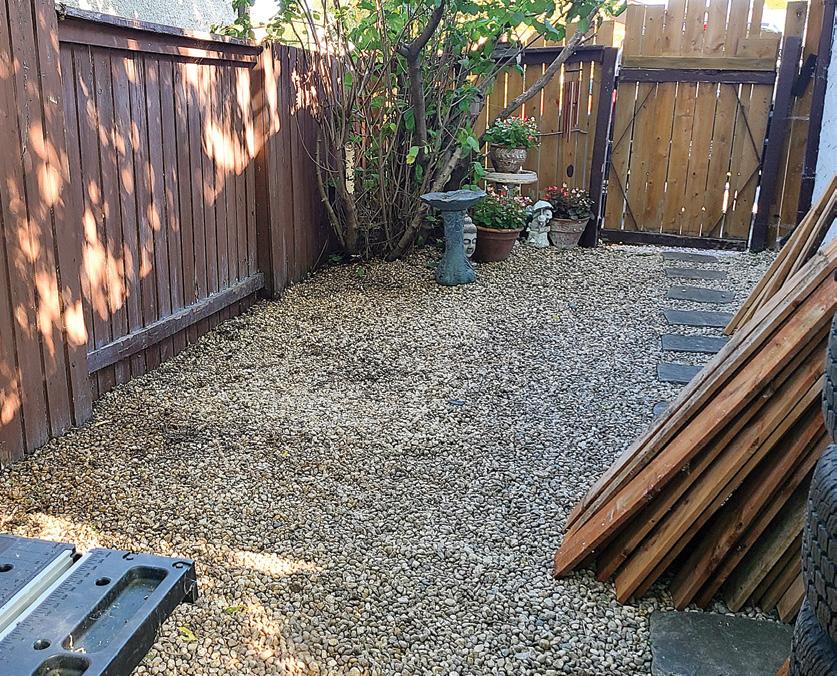
The day arrived and once the cameras had been set up the Olde Dawg and I, having agreed what each was going to say, started. The Olde Dawg went on to say that it is always important to ensure all pieces are present and separated making it easier for installation. That was when I noticed the first issue: the shed we had so painstak ingly unloaded was the incorrect size! That’s right, you read it here, the hardware store had in fact given us a 10’-by-8’-foot shed, had I the space it would not have mattered, alas I didn’t. What a to do?
Once contact had been made with the hardware store, who were most apologetic, we returned the unwanted shed, and returned home with anoth er, a 7’-by-7’-foot Rubbermaid shed.
The base for the shed.

Quickly setting about to increase the size of the small deck by an extra foot, we then set about unloading and construction got underway.

The end result was well worth it. From start to finish it took no more than four hours to complete. Constructing the new Rubbermaid shed could not be simpler. Follow each step one item at a time. These sheds click in place much like lami
nate flooring. You do need an elec tric drill and socket set for correctly rigging the roof of the shed and doors. And don’t try to put on the roof without another Olde Dawg.
You can see the process on the video on our website. Follow the QR code.
What did we learn?
• Always check the dimensions on the box.
• Always have two people complete the build; it is really hard to put the roof on, on your own.



• Make sure that the base or foundation is level and a flat surface.
• Issues can arise, stay calm and relaxed throughout the process.
• Most of all, enjoy your friends, your time and of course, your new shed. p
Where did it go? While we were busy planting, weed ing and tending our trea sures, the clock went right on ticking, turning a glorious growing season into a frantic harvest.
Now what to do with it all… With soaring food prices and food inse curity on the rise, it has never been more important to preserve some of the bounty for those winter days. Well, fear not brave gardeners… there are lots of ways to enjoy the garden long after it has been put to bed for the winter!
Generations before us relied on this time-honoured way to preserve food. How convenient it is to go to the cold room on those days when both Mikey and I have indulged ourselves in our respective creative space. The only dilemma is which jar to open! Deli cious soups of all kinds… hearty vege table, broccoli, cauliflower, tomato. Paired with a thick slice of sourdough bread and maybe a few pickles, apple sauce served over yogurt for dessert, and we have a meal fit for royalty!
We don’t care for canned veggies, preferring to blanch and freeze. The exception is those beans that have become too old and tough. I cook them thoroughly and can them for our yellow lab, Piper. She is happy to comply with our ‘no waste’ policy!
Canning is certainly the most conve nient… just open the jar and heat! But we now know that some nutrients are lost with the high temperatures so we can minimally. Botulism is always a concern with canned food so be sure to follow the guidelines set down by reliable sources. Follow the link in this article for a great resource.
Almost as convenient with fewer nutrients being lost, there is freez ing. It is important to blanche and cool most vegetables first as that
process destroys the enzymes that cause produce to decay. Blanching times vary according to the type of vegetable so be sure to check online for correct blanching times… most will be between 2 and 3 minutes. Plunge the blanched vegetables in ice water immediately and leave them long enough to cool completely, then dry them well on some towels. Two things will spoil freezer food… mois ture and air. To this end we vacuum
seal everything that we intend to freeze. Tip: fill your freezer bags half full and freeze them flat before vacu uming to prevent liquid from being drawn up and impeding the seal.
Glass jars of dehydrated goodies fill several shelves in our cold room. Crispy tomato slices, dried apple, fruit leathers laced with elderberry and chia seeds, and more delicacies are perfect for those evening snacks

in front of the TV. Even chunky soups can be blended smooth then dehydrated and made into “flake”. A heaping spoonful in a mug needs only hot water or broth and a few minutes to rehydrate. Any soup or fruit can be blended and dehydrated for this flake. Bump up the nutri tional value of your salad and add extra flavour by sprinkling flake as a topper (my favourite is borscht flake). Add a bit of water and your favourite spices to tomato flake and turn it into on-demand ketchup or paste. Grind dehydrated cucumbers to powder for awesome tzatziki sauce. Add it to a sauce to flavour and thicken it. The possibilities are endless. Look for sili cone trays in the dehydrator section of where you’re shopping, most likely online.
Three things will compromise your dehydrated food: air, moisture and light. To this end we vacuum seal our jars and keep them in a dark cupboard with the overflow stored in the cold room. Vacuum-sealing jars requires an attachment. I found mine on Amazon.
Fermenting
If you are seeking a sauerkraut
Scan me


Here’s a handy step by step guide to canning.

https://www.bernardin.ca/en/stepbystep.htm
sort of flavour, choose fermenting. If you are on the gut health train, choose fermenting. If you are looking to add variety to your repertoire of healthy and convenient snacks choose fermenting.
Fermenting is likely the oldest form of food storage and crosses almost all cultural boundaries. It’s super easy to do, can eliminate the need to buy those expensive probiotic supple ments, increases the bioavailability of nutrients by breaking down antigens inherent in most raw vegetables, and best of all… it’s simply delicious!
Just pack a mason jar with fresh produce… carrot sticks, shred ded cabbage, sliced beets, cucum ber spears, young green beans with garlic and dill, cauliflower florets,
freshly picked blueberries or almost any veggie… and keep covered with salt brine (glass weights help to keep produce below the brine). Refrigerate when the amount of ‘sour’ suits your taste! TIP: add a grape leaf to provide tannins that keep your veggies crisp.
I have many books on the topic; my favourite is Fermented Vegeta bles: Creative Recipes for Ferment ing 64 Vegetables & Herbs in Krauts, Kimchis, Brined Pickles, Chutneys, Relishes & Pastes, by Kirsten and Christopher Shockey.
Simply store root vegetables in 5-gallon buckets lined with food grade plastic liners filled with slightly damp peat moss or sand. Leave an opening the size of a golf ball for the produce to breathe. It will keep everything garden fresh for about 10 months.
Tip: completely slice off any grow ing tops to keep them from drawing moisture from the root.
Happy winter eating! p
Maggie Connell is an artist and gardener near Fredericton, New Bruns wick. You can see her work on Instagram @maggiecfineart


Hartley Botanic is one of England’s oldest and most respected greenhouse manufacturers, with an increas ingly large following in the US & Canada. The business is known for the beauty, enduring strength and quality of its handmade structures. With decades of knowledge and experience, Hartley Botanic shares factors to consider when purchasing a glasshouse.

The right choice of greenhouse can produce a major enhancement for both your garden and your prop erty overall. The first consideration has to be size, and here’s the golden
rule: work out what size you think you will need… and then double it.
This isn’t as excessive as you might think. Once you experience how much a greenhouse can do, you will crave more space than you might initially imagine.
Aesthetically you will obviously want your greenhouse to sit well in your garden and its surroundings. There are many styles to choose from, so it’s worth taking time to explore all the options before committing.
Selecting a pleasing colour for your greenhouse’s framework is clearly important. Colour can either help the greenhouse stand out or
blend in to its surroundings, or you may want to select a colour that matches with buildings nearby.
There’s an important balance to strike between the style and ambi ence of your greenhouse and its practical function as a space for growing plants.
Mains water and electricity are not absolutely essential, but life in your greenhouse will be far easier with these utilities laid on. Effective ventilation will not only help plants to grow but allow air to circulate with ease for those inside. Condi tions within a greenhouse change remarkably quickly. A few moments
of sun can boost temperatures rapid ly, even on a cold winter’s day. This can stress your plants, so adequate vents should be easily opened and closed to adjust to ambient condi tions.
Once you’ve decided on the style of your greenhouse, you need to consider its ideal orientation in the garden. Factors such as adequate light throughout the day – even in the darker months – can have a huge effect on the success of what happens inside.
Align the building so that its longest sides face east and west; this way it will receive direct sun when it is most in need, during morning and evening, while the excesses of the midday sun will be minimized. Shel tered spots are best, so long as light is not too restricted. Avoid low-lying or excessively shaded areas as these can be frost-prone, and put plants at risk. Finally, if you plan to include grow ing beds, make sure the soil is fertile and easy to work.
You may need to obtain planning consent prior to installing a green house. It’s worth contacting your local planning authority at an early stage, so you get a clear understand ing of what is – and isn’t – permis sible.
A good manufacturer will be able to provide professional quality drawings to help support your planning appli cation. In many cases they will offer installation services too. Be sure to

Check out Hartley Botanic greenhouses here.



https://hartley-botanic.com
establish that installers are qualified, and that service provision such as elec tricity and water will be performed and certified to the current build ing regulations and standards. This will also apply if you’re considering installing a multifuel or log-burning stove inside your greenhouse.
Ultimately, a greenhouse can bring a whole host of welcome benefits to life. Adding value to your property, enhancing your garden, allowing marvellous new growing possibilities, providing a beautiful space that’s a haven of peace and tranquility – perhaps it’s time to let the greenhouse idea take root.

Every Hartley Botanic Glass house is handmade to order, so for customers looking for structures designed perfectly to suit person al interests, lifestyles and tastes, the possibilities really are endless. Customers interested in purchasing a Hartley Botanic Glasshouse visit: www.hartley-botanic.com or call 781-933-1993 for more informa tion. p

Every summer, there is one question that pops up quite a bit: what can I do to get rid of ants in my garden? And the first thing I think is, why – just so you know from the outset of this article where I stand. Nonetheless, after I’ve tried to get you as excited as me about ants, I will offer some eradication methods.

Wonder
This is an amazing insect. It is extraordinarily plenti ful; some estimates say that they make up as much as 20 percent of land-dwelling species in terms of mass. They form social communities that work better than our cities, they problem-solve, and they communicate with each other.
They belong to the same order as wasps (Hymenoptera) and there are around 22,000 species. In Canada, there are 100 species, though you probably come across only about 10.
Ants move at least as much and possibly more soil to the surface than earthworms. They are integral to the mixing, drainage and aeration of soil. They also act as food to various animals, from birds to bears. The summer excrement of brown bears contains about 16 percent ants.
Some plants depend on ants to disperse their seeds. Seeds with elaiosomes – a fatty and protein packed cap on the seed – are carried away by ants, back to the colony. The ants eat the elaiosme and discard the seeds in their middens, along with dead ants and other nutritious (to plants) garbage. There the seeds sprout. This plant strat egy is called myrmecochory and is practiced by plants including trilliums, violas, bleeding hearts and corydalis.

Some ants have become farmers of some sap-sucking insects, most notably aphids. These ants are after the honeydew, or sugary waste, the aphids excrete, and they will actively stimulate the excretion by stroking the aphids with their antennae. Some species of aphids have lost the ability to excrete independent of ants! The ants protect the aphids, defending them, eating the eggs of predators like ladybugs, and moving them from one plant to another. (Incidentally, you can skip the poisons to
control aphids; just spray them off a plant with a stream from the hose. No, you won’t kill them, and yes, they will find their way back up the plant – often with the help of their ant over lords! – but you will have slowed down the destruction. Do it often enough to keep the plant healthy.)
To get rid of ants coming into your home, you must find out where they’re getting in. You can try to seal that area, but these creatures are very small and very deter mined. Surround the area with some kind of powder like salt or baby powder. The ants (probably) won’t cross the powder.
Carpenter ants are big ants, 5/8 inch long. They require some attention if you find many of them in your home because they build their nests in wood by gnaw ing through it. Not a big deal in an old tree stump but definitely a big deal in your wall studs. To get rid of them yourself, it is recommended that you find the nest, drill 1/8-inch holes every 6 inches in the infested wood and, using a bulb duster, puff boric acid into the holes. For myself, though, with anything that is eating the biggest investment of my life, I’d be inclined to call an extermina tor to make sure they are gone.
If you need to get rid of ants in the garden, find the colony and kill the queen or queens. (Many species have more than one queen.) An often-recommended solution is to pour boiling water into the ant hill. You will need to do this several times with plenty of water because ant colonies can go 6 feet deep or deeper. The queen or queens will be well inside the hill, and if you don’t kill them they will be moved even deeper, further away from harm. University of Florida has found that this method works on fire ants 20 to 60 percent of the time. You will also be killing every thing else that gets touched by the boiling water, so this is a last resort kind of solution.
You can try various other things, like surrounding the ant hill with diatomaceous earth. Diatomaceous earth is made of sharp, microscopic exoskeletons that will cut up and dry out ants. The ants can’t go through the stuff to forage for food, so theoretically, the whole colony should die. In reality, you’ll need to reapply it every time it rains a bit. You’ll also need to look for other exit holes the ants may have developed.
Ants are attracted to peony buds because they are sweet with nectar. The ants do not help peonies to open, neither do they hurt peonies. If you cut peonies to bring them indoors, chances are some of the blooms will have ants on them. You can cut your peonies when they’re at the marshmallow stage, when it’s easy to pick the ants off. Or you can cut peonies after they open and plunge them in a bucket of water for a couple of hours. It won’t kill the ants, but they should float on the surface of the water.
You can mix borax with sugar and put that around the ant hill; ants will take the borax-sugar back to the colony and feed it to others, including the queen. This can take quite a while too. It is worth noting that some ant species don’t eat solids so they will never consume the borax-sugar. p

The bullet ant of Central and South America has the most painful sting of any insect. It isn’t usually fatal to humans, though the sting of the jack jumper ant of Australia can be.
The mandibles of army ants are used as sutures in Africa and South Ameri ca. A cut is held together and the ants are placed along it; their mandibles close and their bodies are cut off.
Trap jaw ants and Dracula ants have mandibles that snap shut at 143 miles per hour and 200 miles per hour, respectively.
One species deals with flooding in the nest by drinking the water and excreting it outside.
Honeypot ants store nourishment inside themselves. The storage recep tacle ants hang from the ceiling deep underground, available for other worker ants to come and collect food for themselves and others. I’m not sure how they get the nourishment out of the ants….
Scan me


Check out a video about hang gliding, ant style!
https://www.nsf.gov/news/news_videos. jsp?org=NSF&cntn_id=102807&media_id=66507
All ants use various methods of navigation. They leave a trail of phero mones for other ants to know where a source of food is. They return to the nest by knowing how many steps they took away from it and they find direction by the position of the sun or by the Earth’s magnetic field; some use visual landmarks to guide them. But some species can have their way blocked, in which case they form an ant mill, whereby they follow each other around in a circle endlessly until they die.
An ant in India can leap a couple of inches. Another, which lives in trees in the South American rain forest, can direct its fall from a tree back toward the tree. It looks like it’s flying, though it has no wings. Watch the video by following the QR code.
There is a genus of ant, the Poly ergus genus, that cannot raise its own broods or feed itself. It exists by enslaving a Formica ant colony. A Polyergus queen will invade a Formica colony, replace its queen, and start laying eggs. The Formica work ers care for the eggs and feed all the ants. What do the Polyergus workers, raised by the Formica ants do? They go raid other Formica nests to keep their enslaved population going.
The lemon ant of the Amazon rain forest lives in a particular tree, the Duroia hirsuta. They will kill other plants around their colony by inject ing formic acid into the leaves, killing them and creating what is known as a Devil’s garden.

“In short, if all the matter in the universe except the nematodes were swept away, our world would still be dimly recognizable, and if, as disem bodied spirits, we could then investi gate it, we should find its mountains, hills, vales, rivers, lakes, and oceans represented by a film of nematodes. The location of towns would be deci pherable since, for every massing of human beings, there would be a corre sponding massing of certain nema todes. Trees would still stand in ghost ly rows representing our streets and highways. The location of the vari ous plants and animals would still be decipherable, and, had we sufficient knowledge, in many cases even their species could be determined by an examination of their erstwhile nema tode parasites.” – Nathan Cobb, U.S., Department of Agriculture, 1914
Nematodes have been known to exist from prehistoric times but have been scien tifically identified only in the past few hundred years. In more recent times, common lore often attrib uted crop failures to mineral deple tion and the answer was to pour on the fertilizer, but the astute farmer soon recognized another cause: the buildup of harmful nematodes, particularly where annual crops were being introduced.

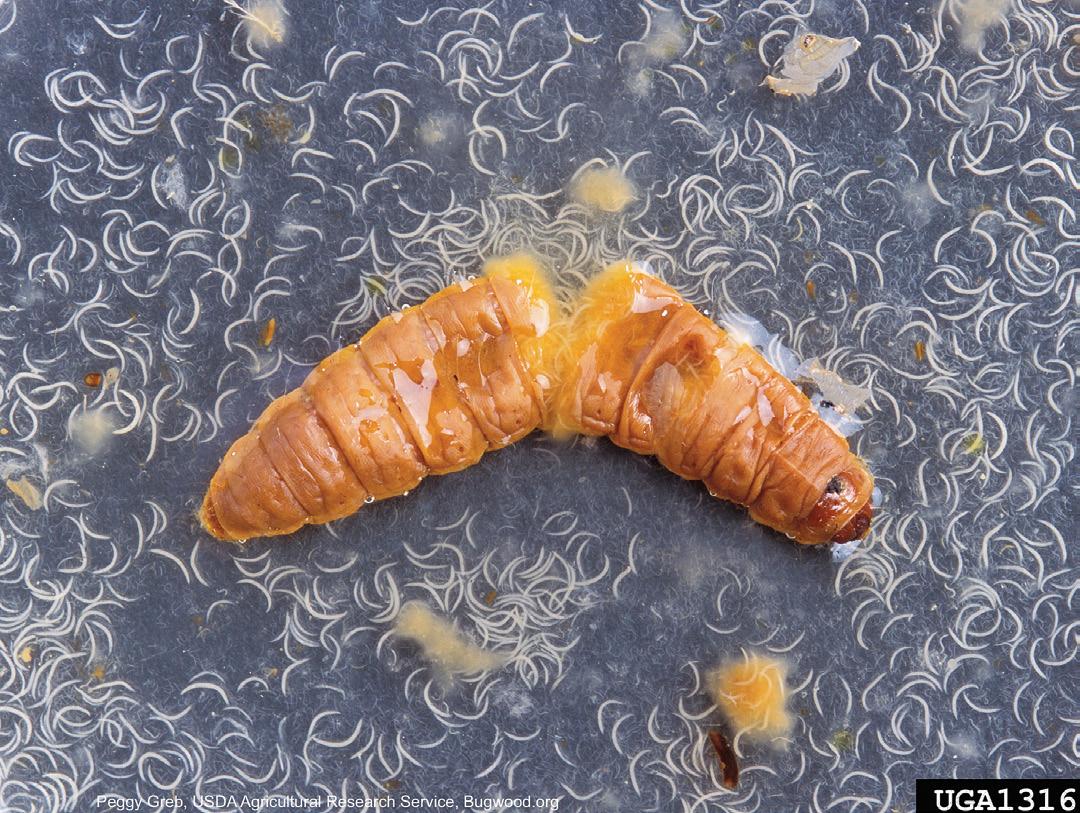
What are nematodes? Also called round worms, these tiny life forms are translucent, non-segmented, worm-like animals, 1/500 inch to 1/8 inch long, that populate the world including our own bodies in countless trillions.
There are several types, some of them beneficial to humans and gardeners and some pathogenic.
Some nematodes play an active role among the roots of growing things, along with bacteria and fungi. These beneficial nematodes feed on bacteria and fungi. The bacteria and fungi tend to contain more nitrogen than the nema todes can process, so some of this nitrogen is released back into the
soil in a form that plants can use. These nematodes also help distrib ute bacteria and fungi in soil and along roots by carrying both live and dormant organisms on their bodies and passing them though their digestive systems.
There are also predatory nema todes that feed on other nematodes as well as on soil dwelling larvae. They can be purchased and used to combat cutworms, grubs, root borer larvae, root weevil larvae, flea beetle larvae, carrot rust fly larvae and other pests. The less disturbed the soil the more preda tory nematodes are likely to dwell.
A third beneficial type, parasitic nematodes, invade and destroy white grubs, pill bug eggs and larvae, Japanese beetle larvae, crane fly larvae, and other insect pests commonly found in lawns and turf.
On the other hand, some patho genic nematodes can feed on the plant roots themselves. They are considered plant parasites and the result of their presence can be seen in stunted plants, in root knots, galls of both roots and leaves,
damaged root tips and branching, and twisted or distorted leaves. Pathogenic nematodes can also cause microbial diseases that show up as brown spots on various parts of the plant.
For the home gardener, the crops most affected at the roots include strawberries, cherry tomatoes, potatoes, peppers, lettuce, corn, and carrots. For leaf and stem inju ries, crops affected include chrysan themums, onions, rye and alfalfa.




Farmers have several strategies to combat the build-up of harm ful nematodes including planting cover crops of plants that either starve the nematodes (this can take years) or gas them to death by planting brassicas and mustards (cabbages, radishes, turnips) that contain glucosinolates (responsible for the bitter taste you experience).
In the home garden, in addition to plant rotation, such plants as paint ed daisy and French marigolds can be used as a green manure to kill harmful nematodes. Dahlia will also repel them.
Another defense is to look for nematode-resistant varieties or use a chemical nematicide.
Where are harmful nematodes most likely to occur?
Coarser textured soils such as sandy loams are the more likely homes for root nematodes which are less prevalent in clay-based loams. Nematodes travel very slowly in dry conditions but can be rapidly transported in wet condi tions and water films. Nonetheless, they exist in every environment on earth, from the ocean floor to deserts to polar conditions.
As with any other life form, nematodes tend to go where the food is so planting the same annual crops, as in vegetable gardens, in the same place year after year will eventually result in a buildup of root hungry nematodes. This is why it is wise to rotate vegeta ble crops, particularly those that attract these unfriendlies.
As mentioned previously, most nematodes are too small to be seen with the naked eye, but if you are really curious and look very hard, you might find some of the larger ones in the compost heap where their translucent bodies can reach a quarter inch in length. p
This is our new-to-us old garden in Winnipeg. After living in Toronto for 27 years, my husband David and I have moved back “home”, where our families live. Not a massive garden, but it’s about four times as big as our old garden. That’s the plus side; the minus side is that we’ve gone from Zone 6 to Zone 3, from 161 frost-free days to 108. And I need to re-learn garden ing.
Top of my list is the lawn. I didn’t have one in Toronto; when we moved into our house there, the front had a lawn of about 140 square feet with a tree on it. It was a hassle to mow and it took up too much space that I needed for plants. The front yard became 2/3 garden and 1/3 walk way. The back of the Toronto house, when we left, was half me trying to grow vegetables and half flowers. Well, less than half because there was a big and growing yew on one side and a mid-sized pagoda dogwood on the other. Also, a pergola with a monster wisteria. Really, the vege table garden was about 6 by 8 feet, and the flower garden was about the same.
Now I have a lawn in the southfacing backyard and the north-facing front. These are mostly grass and very green, save for a couple of dead spots left by the previous owner’s dog. In the spring, perhaps I will scatter some clover seeds in the back and I’m thinking about wild straw berry seeds, Fragaria vesca or F. virginiana. I know it sounds crazy, but these plants can be mowed and the tiny strawberries will simply grow lower. I doubt we’ll get any to eat because our little old dachshund, 16-year-old Penny, will probably enjoy them as they grow. The straw berry plants will offer punctuations of white flowers and, for those she doesn’t get, red fruits that will be lovely to look at.
The side of our backyard ends where the neighbours’ house begins and they have a couple of basement windows. I don’t want to block those
So much patio space!

with trees, but I do want to plant a couple of apples, and I want to put in a row of raspberry canes. The trick will be to do that without blocking the sunlight from the neighbours.
Now, I need to reserve some of the south-facing space for a kitch en garden. I’m intrigued by Greg Auton’s method (which he took from Ruth Stout) of getting a new garden bed by planting potatoes. You select your area in the spring, put seed potatoes on the grass spaced as they would be in a bed, and cover it all with 12 inches of straw or other mulch. Through the summer, you top up the straw. And in the fall, you harvest the potatoes. After that you have no grass and lovely soil to plant in under all that straw. The potatoes are a bonus!
I’ll need ornamentals in the back garden too because, well, because they are beautiful. I dream of a
wide garden full of Shasta daisies, cat mint, ratibidia and Maltese cross and more, backed with masses of delphiniums. How will I fit this in and still have my lawn?
There is purple martin house in the middle of the backyard that is occu pied by a huge number of sparrows. Honestly, I don’t mind the sparrows. They eat mosquitoes and they sing. Bird aficionados will tell you and me both that sparrows are a foreign invader and should not be tolerated, though. It needs to come down to be fixed up and painted. I’ve suggested that it should be painted now, to give it time to get rid of the smell before spring, but my husband has other ideas. So we’ll do it next fall.
The fence between the front and back hosts Englemann's ivy. I’m thinking of planting grapes here. It will take a few years for them to amount to anything, and the birds
will probably get them all. That’s okay, though.
There are planters along house at the back, and I’ve planted bulbs there and beside the house, which is very gravelly. Alliums, crocuses, daffodils and a ground cover tulip mix. I ordered them from Veseys with a note to not send them before I got here. I was sure I’d ordered far

too many, but no... it’s going to take some getting used to, this largerscale gardening.
Behind everything I have described, there is a beautiful patio with an insulated garage and an arbour deep enough for a conversation set and a dining area. Quite a step up from our too-small pergola in Toronto that I tried to fit the family under
for meals. I’m hoping to convince my husband that we should heat the garage to around 0 degrees so we can keep a couple of figs and lemon trees in there through the winter.
In the front, there is a wide bed that was more formally planted some years ago. It has dogwood shrubs and an area thickly overgrown with irises. We don’t know if they are all



the same or what colour they are, so I’ll let them go until they bloom next spring, then divide them and give a bunch away.
There are also two young Ohio buckeyes on one side of the front walk. I’m not sure I want either of them, and I do worry about how big they’ll get. I would rather have trees that provide something I can eat, not something that can poison me. On the other side of the front, in the neighbours’ yard, is a beauti ful big old oak that won’t live much longer. I’m wondering what the local etiquette is about asking them to call an arborist.
A cherry tree grows a little bit too close to the front of the house, but we’ll see how it produces in this spot. Will I need a second tree for good pollination? When we took possession of the house in the summer there were only a couple of cherries on it, but baby cherry trees around the yard suggests the one near the house doesn’t do too badly. Birds must be gobbling the fruit. Next summer, I’ll put netting over the tree to let the cherries grow and ripen.
A mid-size linden in the front yard has been the darling of a sapsucker. It is pockmarked with lines of holes along its entire trunk, yet the tree seems healthy and has a beautiful pyramid form. My husband likes it.

On the other side of the house are a bunch of heavenly old lilac trees. And at the base of them, a rhubarb is growing. The house dates to 1905, so I imagine that rhubarb has been growing for about a century, resisting all attempts to dispatch
A sapsucker has had a field day here, but the tree shows no signs of damage in the canopy.
it. I’m curious how this old guy tastes, growing in the shade under the lilacs. Its roots must be tangled in with the shrubs so I’m sure we won’t be taking it out anytime soon.

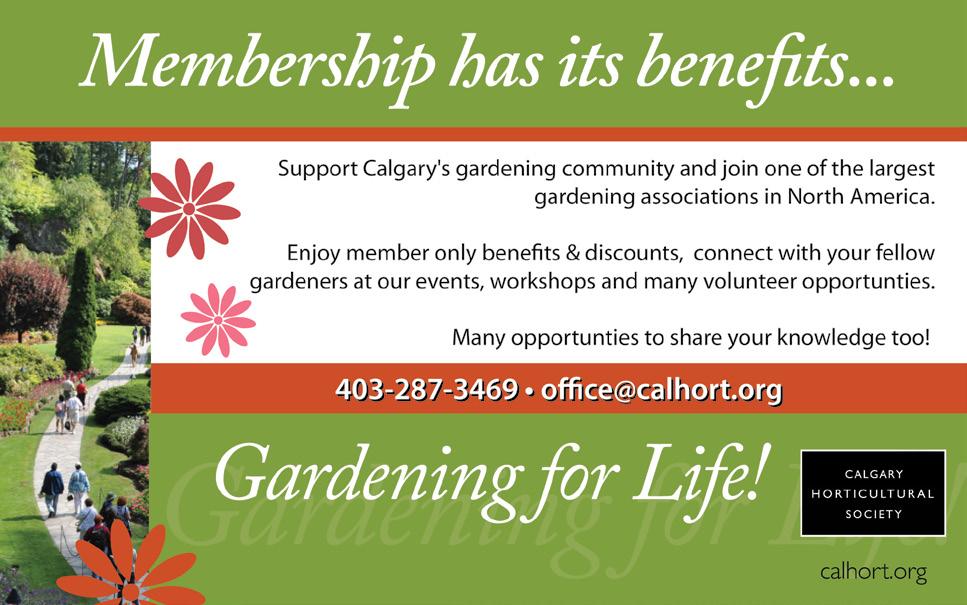
I’m really looking forward to planning out our new old garden. I’ll be sure to tell you about what’s coming in the spring issue! p


An area for entertaining.

The house is under huge, beautifully pruned trees.
When you are in politics, espe cially civic politics, your life is hardly your own. So it is for the mayor of Chilliwack, BC, Ken Popove. But he has a special elixir that keeps him energized and able to deal with everything that is thrown his way: he gardens!

This is no idle pastime. Ken has turned his property into a green para dise complete with a pool and lots of leafy lounging places. He even has a
greenhouse, his secret retreat when the pressures of office demand time for reflection. There is no better place to set the mind in action than greens paces and a garden. Indeed, stud ies have shown that the mind works better during and after exposure to nature, among trees and greenery.
Ken’s skill as a gardener is painted in his front yard where he has created a forested space relying heavily on shade plants with a mosaic of exotic West
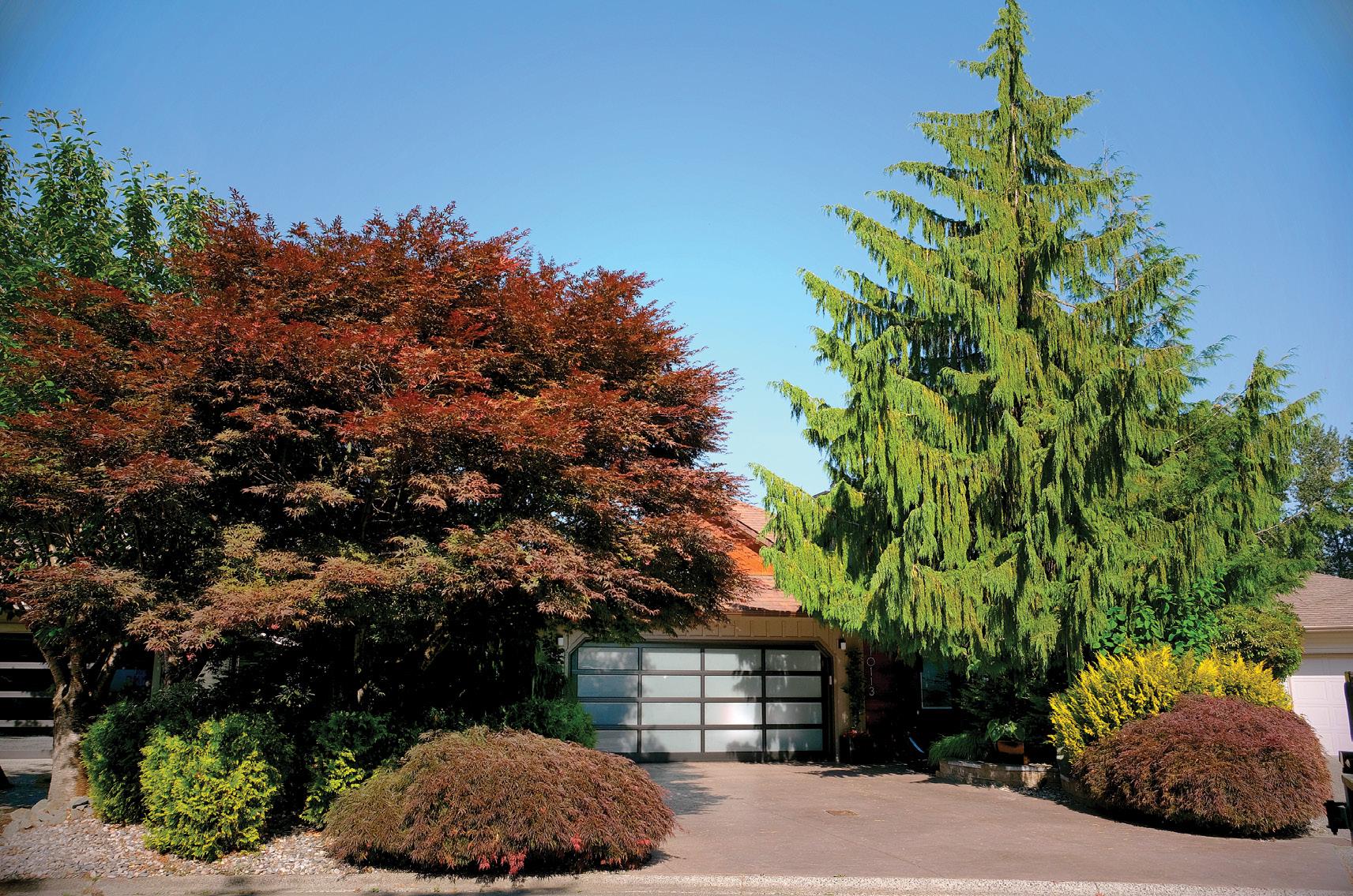



A water feature, tucked away.
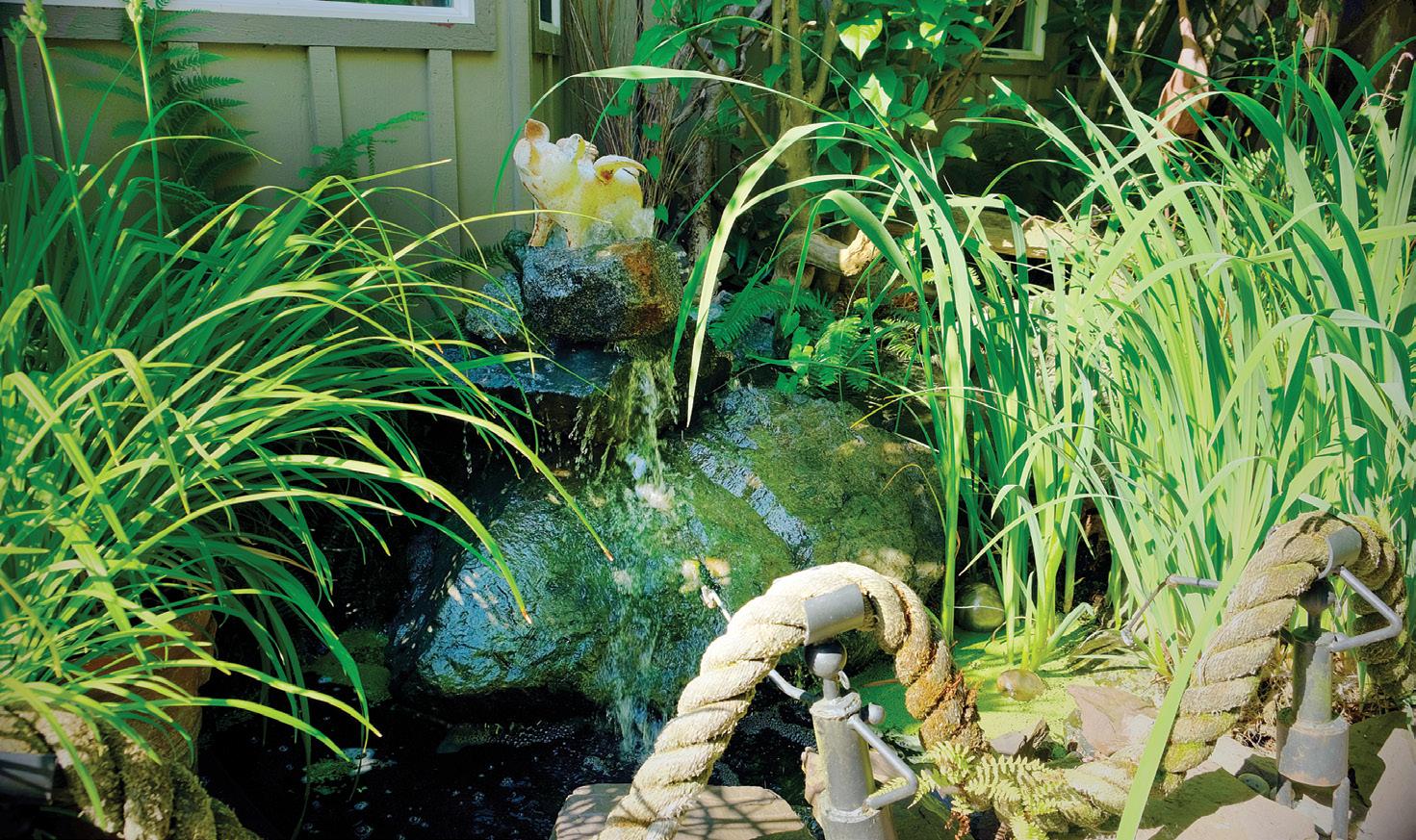

Coast shrubs and trees such as the lovely weeping Alaska cedar, Japanese maples, and dwarf chartreuse cedars that look like sunshine peeking out from under the larger shrubs. He has an eye for colour and texture, not only in plants but in his choice of furnish ings. As an example, on the wall of his greenhouse, he has two wall plant ers painted with a metallic purple and filled with wine-coloured oxalis, an imitation-worthy pairing. He is not just a gardener in theory. His work is evident in the lower planter which doubles as a hanger for a pair of prun ers stuck in the corner. Other planters contain vines spilling onto the natural growth. Tall containers are made even taller with slender upright plants.
Ken also has a fondness for orna mental surprises which he places stra tegically to catch the eye. An enchant ed winged, pink pig lords it over a waterfall that spills over interesting rocks and flows away under a wooden bridge (that pig or his mate also shows up in a window box behind some geraniums). Bits of driftwood, tree stumps, stones of all sorts, surprising and unique ornamental touches such as the curved wooden birdhouses or a sign peeping from a little wild space saying, “Ground under repair”, join two copper containers, what appears to be Maritimer’s rope, and a large
The round pool.
piece of driftwood planted upright, pointing spear-like to the sky against a backdrop of greenery. There is more, but it so cleverly placed you have to look hard to see it all.
Following a sun-dappled path way to the back of the house leads to a totally different mood. A round swimming pool set in a raised cedar deck is open and sunny. Next to this garden entrance, there is a lovely open kitchen complete with cupboards and counters that doubles as a bar. It is sheltered under a cedar roof, as is a small “sitting room” furnished with comfy cushioned chairs and a settee, next to it. The dining area hosts a high round table surrounded by stools.


On the opposite side of the pool under a sheltering corner roof, a large, round lounging chair waits for his mother who comes over Sundays to enjoy the sunny days of summer.
Then there is Ken’s greenhouse, hidden off the beaten trail behind the kitchen. This is his happy place where he can putter and dream undis turbed. He is growing herbs and the space is filled with more of the clever
Scan me





To see more of Ken Popove’s garden scan here!
https://www.localgardener.net/ garden-of-ken-popove/
finds that intrigue him. One is an old tin sign reading, “Ken’s Livery and Wheelwright”. It seems he has a lot of hidden talents.
There is not much sun but what there is houses raised beds featuring a potager housing vegetables such as beans, tomatoes, and a squash plant. Ripening raspberries shine shyly from behind healthy leaves.
Everything in this garden is meticu lously planned and cared for. It says a lot about the Mayor of Chilliwack. It would be hard to imagine a disordered city management under his leadership. The garden also speaks of creativity and intelligence. Lucky Chilliwack. p
There is beauty in every corner.

When my husband, Robert Wrigley, and I moved into our home in Winnipeg, landscap ing was minimal. Numerous large trees and shrubs, largely planted at random, and looking rather ragged from competition and old age, cast shade over both front and back yards, leaving little exposure for floral gardens. Thir ty-five years later, and with some stra tegic tree and shrub removal, the sun now has free play to almost all areas of the yards, and flower beds adorn the pathways that meander around all sides of the home. New features, such as a wooden deck, a richly coloured stone patio, a tiled gazebo, and a refurbished ‘Florida room,’ offer a variety of places to lounge, read and enjoy the vistas and serenity of the home, far from the noise of traffic, and offering choices of sun or shade. A new wood-fired pizza oven in one corner has already garnered a waiting list of requests from hungry friends. A 5-foot-high inuksuk, which Robert constructed out of local rocks, adds interest even when partially covered with snow.
Neither of us described ourselves as gardeners when we moved in. I am a long-time cellist with the Winnipeg Symphony Orchestra, while Robert, a retired ecologist, held positions of Museum Director at the Manitoba Museum, founding Director of the Oak Hammock Marsh Interpretive Centre, and Curator of the Assiniboine Park Zoo. When I joined the Board of Directors of the WSO, Chairper son Dorothy Dobbie appointed me
Plants growing in place of hair.
Chair of the Garden Soirée Commit tee, which raised funds annually by arranging public viewing of diverse gardens selected by Dorothy. Observ ing the diversity of flora, plus inspira tion by the many gardeners I met each year, provided the catalysts I needed to begin developing my own gardens, first in the back yard, and eventually all around the home. I also regularly
accompanied my sister Karen Dahl (a prolific gardener) to greenhouses in Winnipeg and the surrounding towns. Lacking confidence about which plants to purchase, I routinely followed Karen’s advice – whatever she put in her plant trolley, I put in mine. Robert’s botanical interests were focused on raising succulent plants, an extensive collection he later donated to

the Assiniboine Park Conservatory in Winnipeg.


Over the years, I envisioned addi tional garden spaces featuring new flower varieties that demanded inclu sion in the gardens. In compliance with his new head-gardener instructions, Robert diligently dug up sod, wheel barrowed in countless yards of topsoil, sand and sheep manure, laid over 2000 paving stones, and helped construct the new patio and gazebo. The latter struc ture turned a weed-covered corner into the yard’s prime sitting area, offering the best view of the expanded garden. To increase our viewing pleasure of the front yard, while sitting in the glassenclosed patio, we now have two raised gardens. A long brick garden bed is generally host to gaily coloured petu nias. The second, bounded by thick blocks of beautiful white stone, displays

new varieties of annuals and peren nials, backed by eye-catching sprigs of Russian sage and bright yellow ‘Sunstruck’ false sunflowers. The result is now a landscaped property that the former owners would not recognize.



The current backyard garden is actually a revised version, since over a decade ago, we installed a geother mal heating and cooling system, which necessitated the elimination of the existing lawn and garden beds during excavation for a network of polyeth ylene ground loops involving 30 drill holes, each descending to a depth of up to 50 feet. Fuel savings, plus the recent addition of 32 solar panels on the roof, now qualify the home as highly energy efficient, even with the large number of windows.
I like to acquire varieties of plants with musically themed names, such Deep coloured flower signifies the end of summer.
Colourful pots of flowers brighten up this seating area.

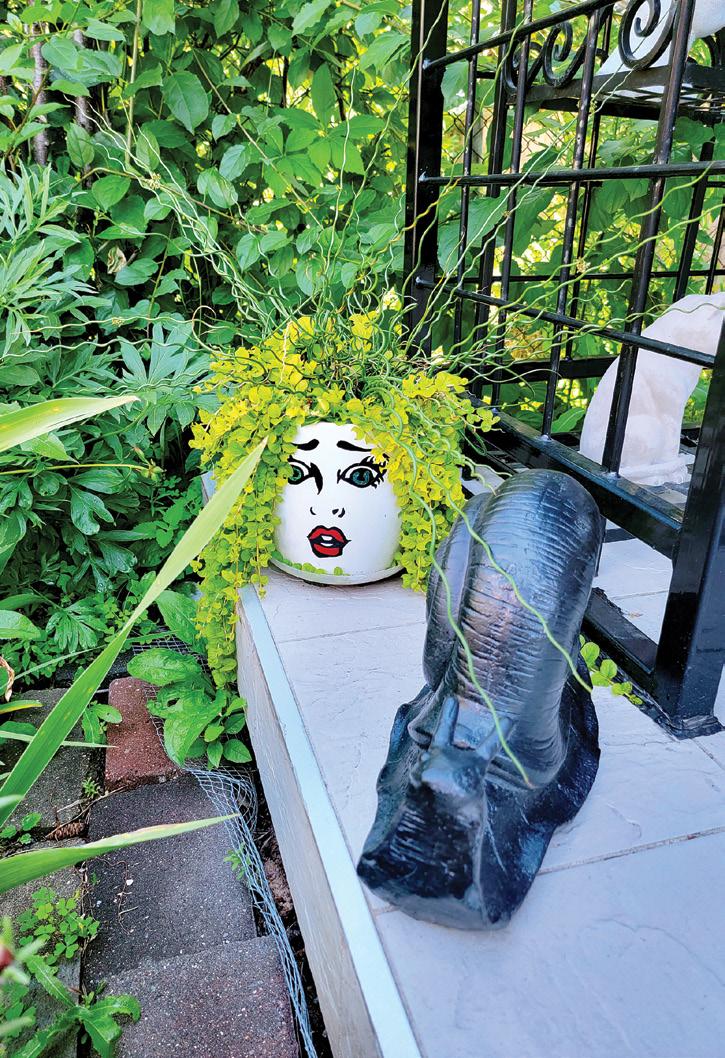

No deer allowed.
“My hair must be a fright!”
To see more of Arlene Dahl and Robert Wrigley’s garden scan here!
https://www.localgardener.net/garden-of-robertwrigley-arlene-dahl/



as ‘Oscar Peter-son’ rose, ‘Beverly Sills’ iris, ‘Rock and Roll’ and ‘Tango’ astilbes, and ‘Salieri’ daylily, as well as plants with black or dark purple flow ers, such as ‘Midnight Madness’ iris and ‘Armageddon’ daylily. Stands of swaying Joe Pye weed attract bees, hoverflies and painted lady butterflies, dill attracts black swallowtails, and milkweed provides food for monarchs. Several large pots are reserved for herbs, which are snipped regularly for pizzas and other meals. The gazebo and garden paths are appointed with Greco-Roman and music-related busts, including a Beethoven, whose coif fure is carved out at the top to accept a potted plant. Also scattered around the garden and gazebo are comi cal metal sculptures of a goat, sheep, peafowl, snail, and a frog on a spring, which visitors cannot resist twisting to watch it shimmy. Flags (five exhibited at a time) hanging along the backyard fence contribute additional interest and colour, and represent places where we have lived or visited repeatedly.
Not satisfied with the spaces offered by seven garden areas, I decided to point my green thumb in the direction of pot-scaping. Numbering at one time 85 pots of flowers, these have been reduced to 50, although I compensated for this by installing 21 hanging baskets. To enjoy the garden view after sundown, I added 60 solar-powered lights along the garden pathways, in pots, and in the ceiling of the gazebo, which cast an inviting glow through out the yard. We decided recently to secure the backyard gardens from visit ing cottontails and white-tailed deer by installing wire and steel fences and gates. While these herbivores can still nibble on sweet potato and flowering plants in the two raised gardens in the front yard, plants in the backyard are finally safe. As all gardeners know, there is always another project around the corner, and new varieties of plants to introduce into the garden landscape, helping to create a symphony of flow ers. p

Visiting the garden of a collector is always a wonder. How many varieties of the plant do they have? Where do they shop for them? The collection is invariably far beyond what is sold or what has been sold at local nurseries for many years. This is the expectation you have when you go to visit the garden of esteemed judge and avid gardener Ken MacDonald in Charlottetown. When you arrive, all these assumptions fall away, and you are drawn into his incredible garden.
Ken died last summer a few weeks after our visit. He leaves behind an astonishing 900 varieties of hosta.
Nine hundred.
Varieties!
And yet his garden did not look like a collector’s garden. It looked like a beautifully worked and kept general garden that contained a lot of hostas.

A collection of hostas in so many shades of green.
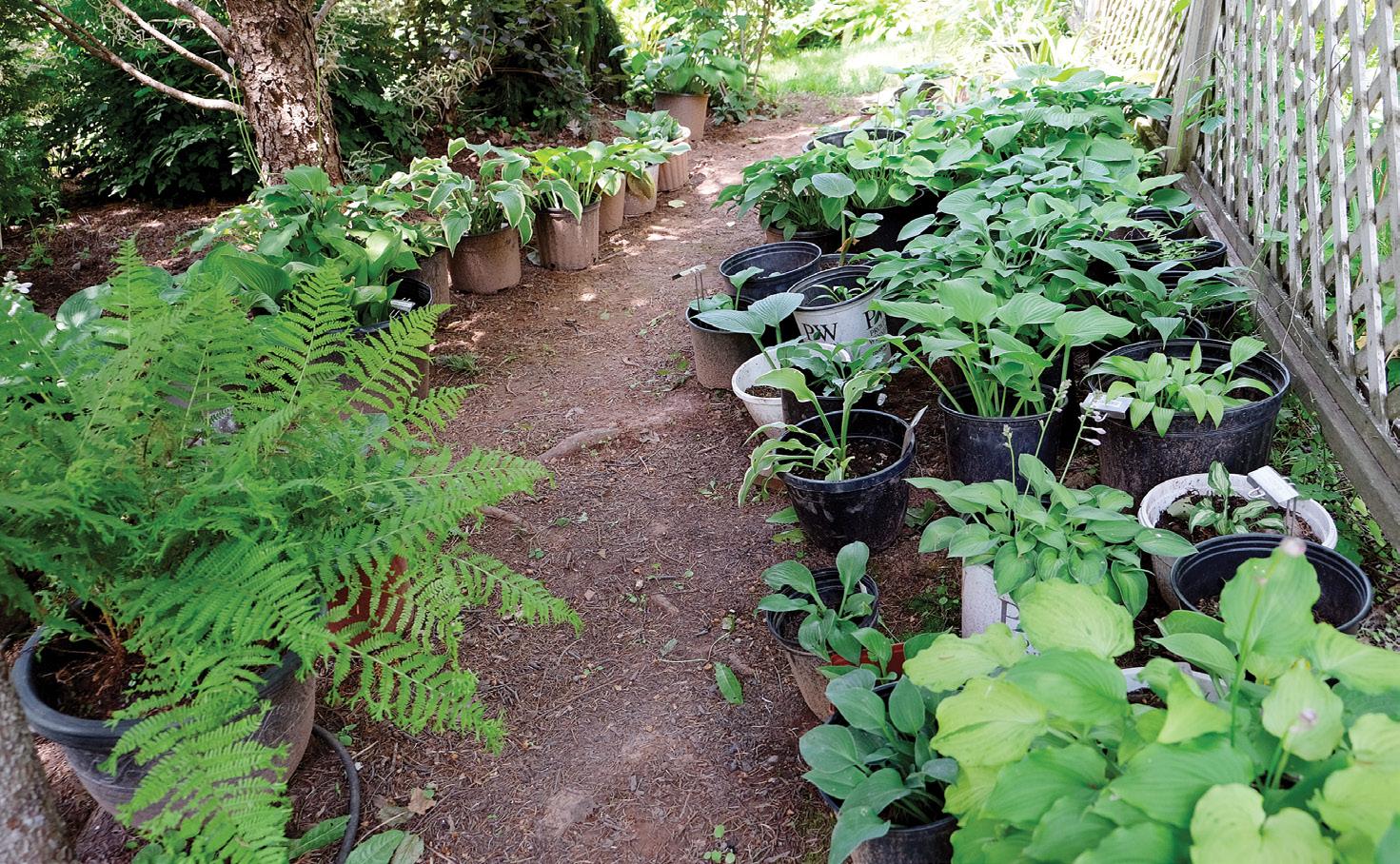
New hostas, waiting to find their place in the garden.

The statue seems to say, “how will I remember all these names?”
A wider view of the back yard. This is a working garden.
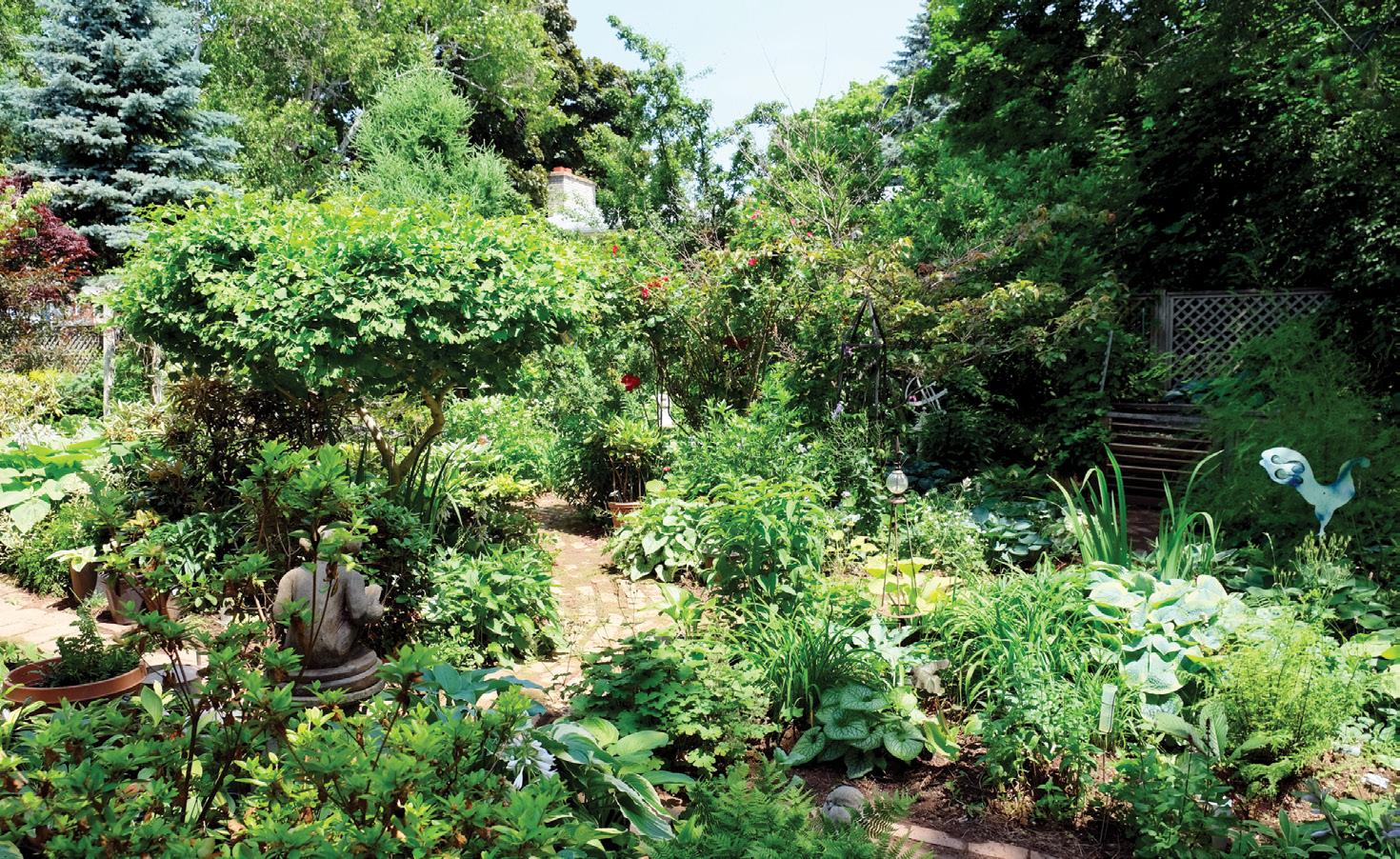

A pagoda dogwood stretches out its arms, protecting
Ken loved all plants. Foliage is of utmost importance here; flowers are just something some plants happen to produce. Occasionally they draw attention, such as with the begonias that arrest the eye. The textures and variations of size and shape are the real focus here, and Ken manages to play them off of one another with the accomplished sensitivity of a true virtuoso.
The house is at the corner of two streets, with plenty of frontage. All of it is obscured by trees and borders of grasses, shrubs and peonies, except for a bit next to a blue spruce, where you can spy a bow window behind a border of drying alliums, rodgersia and a weeping caragana.


Around the back is a series of brick pathways between lush plantings of hostas, yes, but every kind of plant that will grow on PEI, and surely some that usually won’t grow here. Trees and shrubs give a dappled shade that provides a sunny spot for a daylily and a yellow hosta here, a shady spot for a brunnera and blue hosta there. You can imagine garden parties happen ing in this area long ago, before so much ground was given up to vegeta tion. Today it is a plant enthusiast’s wonderland. p
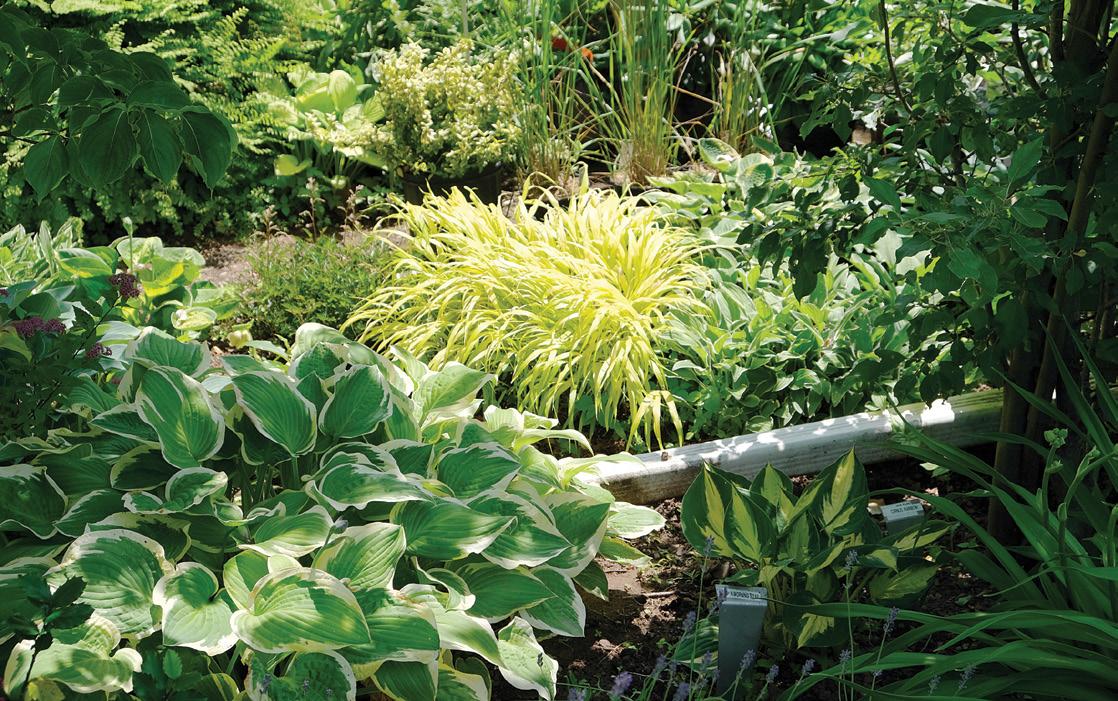

Scan me


To see more of Arlene Dahl and Robert Wrigley’s garden scan here!
https://www.localgardener.net/garden-of-kennethmacdonald/
As a postscript to this article, the following commentary has been provided by our PEI Editorial Board member John Barrett.

“Shortly after our visit to his wonderful garden, Kenneth Ross MacDonald, former Chief Justice of the Prince Edward Island Supreme Court Trial Division passed away while on vacation in Edinburgh, Scotland. Ken volunteered with many organizations throughout his life; Trinity United Church, PEI Garden Club, Friends of the Farm, Charlottetown Curling Club, Char lottetown Minor Hockey Associa tion, Law Society of PEI, Canadian Bar Association, Canadian Judicial Council and was Chairman of the UPEI Board of Governors.”
“He was a curler who represented PEI in five Briers and one Mixed National and was inducted into the PEI Curling Hall of Fame in 2011. In 2012, he received a City of Char lottetown Mayor’s award for his dedication to the PEI Garden Club, his commitment to creating beauti ful gardens in the City and for shar ing his gardening knowledge with the community. A true renaissance man, Ken will be missed by all those in the gardening community as well as the many other areas of life in which he excelled.”



A singular lily and six feet away

Of all the lilies, a fleeting blossom that captures the imagination of an entire forest


No thought of projecting itself out there further into the open plains, into fields of gold, happy with the ditch it’s in, taking up its sun-given space and nothing else


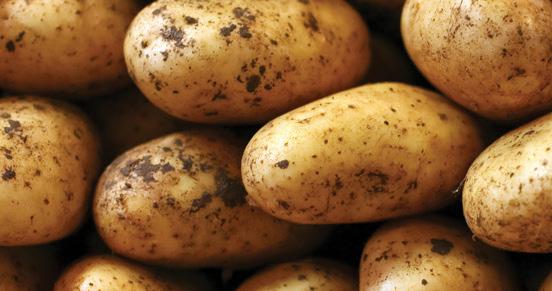 – By Anthony Di Nardo
– By Anthony Di Nardo
Taken from Anthony Di Nardo’s book of poetry Forget Sadness Grass, compliments of Ronsdale Press.





